
UNITED STATES
SECURITIES AND EXCHANGE COMMISSION
Washington, D.C. 20549
SCHEDULE 14A INFORMATION
Proxy Statement Pursuant to Section 14(a) of the
Securities Exchange Act of 1934
Filed by the Registrant 
Filed by a Party other than the Registrant☐
Check the appropriate box:

Preliminary Proxy Statement

Confidential, For Use of the Commission Only (as permitted by Rule 14a-6(e)(2))

Definitive Proxy Statement

Definitive Additional Materials

Soliciting Material Pursuant to §240.14a-12
| ☐ | Preliminary Proxy Statement |
| ☐ | Confidential, For Use of the Commission Only (as permitted by Rule 14a-6(e)(2)) |
| ☒ | Definitive Proxy Statement |
| ☐ | Definitive Additional Materials |
| ☐ | Soliciting Material Pursuant to §240.14a-12 |
FOOT LOCKER, INC.
(Name of Registrant as Specified in its Charter)
(Name of Person(s) Filing Proxy Statement, if Other Than the Registrant)
Payment of Filing Fee (Check the appropriate box):

No fee required.

Fee computed on table below per Exchange Act Rules 14a-6(i)(1) and 0-11.
| ☒ | No fee required. |
| ☐ | Fee computed on table below per Exchange Act Rules 14a-6(i)(1) and 0-11. |
|
|
|
(1) | Title of each class of securities to which transaction applies: | |
|
|
|
| ||
(2) | Aggregate number of securities to which transaction applies: | |
|
|
|
| ||
(3) | Per unit price or other underlying value of transaction computed pursuant to Exchange Act Rule 0-11 (Set forth the amount on which the filing fee is calculated and state how it was determined): | |
|
|
|
| ||
(4) | Proposed maximum aggregate value of transaction: | |
|
|
|
| ||
(5) | Total fee paid: | |
|
|
|

Fee paid previously with preliminary materials.

Check box if any part of the fee is offset as provided by Exchange Act Rule 0-11(a)(2) and identify the filing for which the offsetting fee was paid previously. Identify the previous filing by registration statement number, or the Form or Schedule and the date of its filing.
| ☐ | Fee paid previously with preliminary materials. |
| ☐ | Check box if any part of the fee is offset as provided by Exchange Act Rule 0-11(a)(2) and identify the filing for which the offsetting fee was paid previously. Identify the previous filing by registration statement number, or the Form or Schedule and the date of its filing. |
|
|
|
(1) | Amount Previously Paid: | |
|
|
|
| ||
(2) | Form, Schedule or Registration Statement No.: | |
|
|
|
| ||
(3) | Filing Party: | |
|
|
|
| ||
(4) | Date Filed: | |
|
|
|

Annual Meetingof Shareholders
Proxy Statement
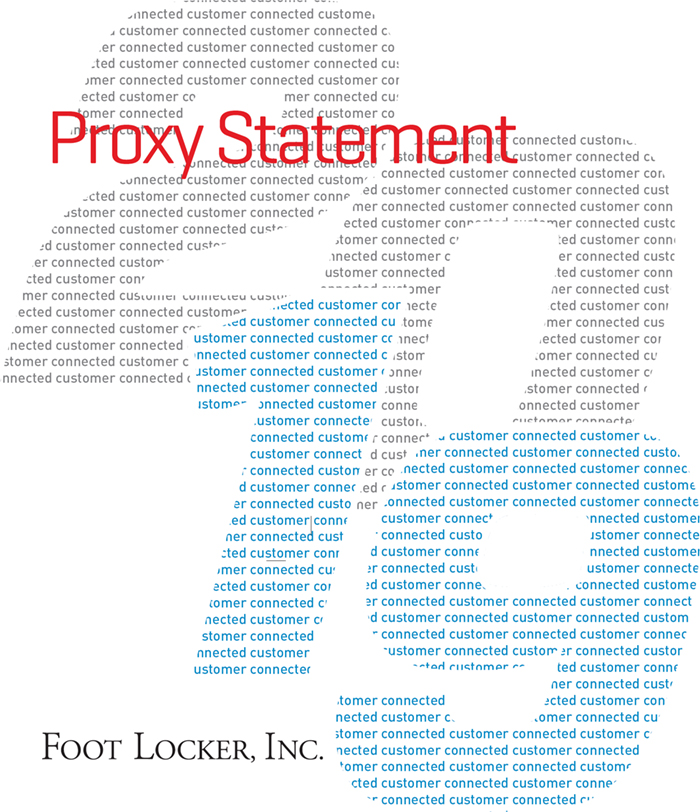


Connecting With Our Customers


330 West 34th Street
New York, New York 10001
Letter from our Chairman and Chief Executive Officer
April 13, 201812, 2019
Dear Fellow Shareholder:Shareholders:
While 2017 proved to be aLast year, with many challenges for Foot Locker, Inc., we remained a highly profitable company and I am proud of the way our team handled the dramatic shifts influencinghighlighted how our customers’ rapidly-changing preferences and shopping patterns. Againstbehaviors–fueled by access to information, influences, and ideas from around the world–were challenging for our Company and the broader retail industry. This year, I am pleased to report that, by focusing on our commitment to elevate the customer experience across each of our channels and leveraging our strategic brand partnerships, we continued to differentiate our business and build positive momentum through each quarter of 2018. In 2019, we will continue to build on our strengths and seize opportunities to evolve our business by developing our internal assets and expanding into new markets.
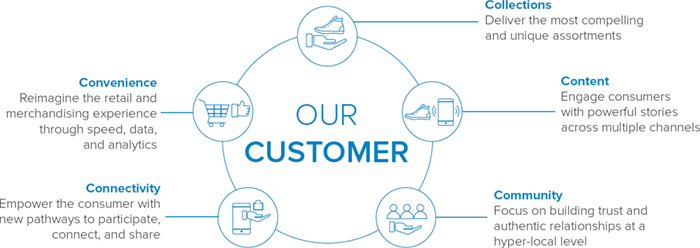
Everything we took do starts with the customer. Our new strategic framework is built on knowing, engaging, and serving our customers–wherever and however they want to interact with us–in 2017. Our Board of Directors took a critical look at governancestore or online. By executing against this framework, we believe we will have the focus and tools to assess how we can more effectively protect and increase the value of your investment:achieve our four key strategic imperatives:
 |  |  |  |
customer experience | long-term growth | drive productivity | leverage the of |
Sales Mid-Single Digit Compounded Annual | Sales per Gross Square Foot $525 - $575 | Earnings Before Interest and Taxes Margin Low Double-Digits* | Net Income Margin High-Single Digit | Return on Invested Capital Mid-Teens | Inventory Turnover 3-4 Times* |
| * | Because these non-GAAP measures are uncertain, these amounts have not been reconciled to GAAP. |
Welcome to the Foot Locker, Inc. 2019 Annual Meeting of Shareholders
| ○ | Carbon38 – a destination for women’s luxury activewear |
| ○ | GOAT Group – a managed marketplace for customers to buy and sell authentic sneakers |
| ○ | PENSOLE – a footwear design academy that, together with us and our |
| ○ | Rockets of Awesome – a |
| ○ | Super Heroic – a lifestyle brand that designs, manufactures, and markets children’s footwear, clothing, and accessories |
 |  |  |  |
| Community | |||
We continuously look for new and better ways to foster a diverse and inclusive work environment, engage our surrounding communities, improve employee safety, and minimize our environmental impact, all while creating value for our shareholders.
LetterShareholder Engagement. We extended our proactive shareholder engagement program in 2018. These meetings provide an important platform to receive feedback from investors and are in addition to our ChairmanInvestor Relations team’s ongoing efforts. We believe this engagement program promotes transparency between the Board and Chief Executive Officer
The Notice of 20182019 Annual Meeting of Shareholders and Proxy Statement contain details of the business to be conducted at the 20182019 Annual Meeting.
Your vote is very important to us, so regardless of whether you attend the meeting, please vote your shares.
On behalfThis is an exciting time for Foot Locker, Inc. We are proud of what we accomplished in 2018, but we are just getting started on our new journey toinspire and empower youth culture. By focusing on our strategic imperatives, leveraging our global presence, and putting the Boardcustomer at the center of everything we do, we believe we will build upon last year’s momentum and the management team, I want to thank you for your patience and support as we navigate through the turbulence that defines the retail industry today.deliver against our updated long-term goals. I look forward to greeting as manysharing our success with each of you as possible at the 20182019 Annual Meeting.
Sincerely,
 | Richard A. Johnson Chairman, President and Chief Executive Officer |


Richard A. Johnson
Chairman, President and Chief Executive Officer

330 West 34th Street
New York, New York 10001
Notice of 2018 Annual Meeting of Shareholders
 |  |  |
| Location | Record Date | |
May 22, 2019 at 9:00 a.m., Eastern Daylight Time (“EDT”) | NYC33, 125 West 33rd Street, | |
► (see page 76 for directions | ||
| Shareholders of record as of March | ||
Items of Business
| Proposal | Board’s Voting Recommendation | ||
 | Elect ten members to the Board | ||
| ✓ FOReach nominee | |||
 | Approve, on an advisory basis, our named executive officers’ (“NEOs”) compensation | ||
| ✓ FOR | |||
 | Ratify the appointment of KPMG LLP as our independent registered public accounting firm for the | ✓ FOR | |
Transact such other business as may properly come before the meeting and at any adjournment or postponement of the meeting
Proxy Voting
You may vote using any of the following methods:
Telephone
| If you are located within the United States or Canada, you may vote your shares by calling 800-690-6903 and following the recorded instructions. Telephone voting is available 24 hours a day and will be accessible until 11:59 p.m. EDT on May 21, 2019. The telephone voting system has easy to follow instructions and allows you to confirm that the system has properly recorded your vote. If you vote by telephone, you do NOT need to return a proxy card or voting instruction form. | |
Scanning
| You may scan the QR Code provided to you to vote your shares through the internet with your mobile device. Internet voting is available 24 hours a day and will be accessible until 11:59 p.m. EDT on May 21, 2019. You will be able to confirm that the system has properly recorded your vote. If you scan your QR code to vote, you do NOT need to return a proxy card or voting instruction form. | |
Ballot
| You may vote | |
Internet
| You may vote your shares through the internet atproxyvote.com. Internet voting is available 24 hours a day and will be accessible until 11:59 p.m. EDT on May 21, 2019. As with telephone voting, you will be able to confirm that the system has properly recorded your vote. If you vote via the internet, you do NOT need to return a proxy card or voting instruction form. | |
| If you received printed copies of the proxy materials by mail, you may vote by |
April 13, 2018All shares that have been properly voted and not revoked will be voted at the Annual Meeting. If you sign and return a proxy card but do not give voting instructions, the shares represented by that proxy card will be voted as recommended by the Board.
Your vote is very important to us. Please exercise your right to vote.
Important Notice Regarding the Availability of Proxy Materials for
the Annual Meeting of Shareholders to be Held on May 23, 201822, 2019
The Company’s Proxy Statement and 20172018 Annual Report on Form 10-K are available athttp://materials.proxyvote.com/344849.
April 12, 2019
Sheilagh M. Clarke
Senior Vice President,
General Counsel and Secretary

Table of Contents

Proxies are being solicited by the Board of Directors of Foot Locker, Inc. (NYSE: FL) (“Foot Locker,” the “Company,” “we,” “our,” or “us”) to be voted at our 2019 Annual Meeting. As this is a summary of our Proxy Statement, please refer to the complete Proxy Statement for more complete information.
2019 Annual Meeting of Shareholders
2018 Annual Meeting of Shareholders
Record Date: March |  | ||
| Elect ten | ✓FOReach nominee | 1 | |
 | |||
| Approve, on an advisory basis, our NEOs’ compensation | ✓FOR | 32 | |
 | Ratify the appointment of KPMG LLP as our independent registered public accounting firm for the | ✓FOR | |
| 69 |
On or about April 13, 2018,12, 2019, we started mailing a Notice Regarding the Internet Availability of Proxy Materials to our shareholders.
 | 
|
Summary

Director Nominees
Ten directors are standing for election at the 20182019 Annual Meeting for one-year terms. Jarobin Gilbert, Jr. will be retiring from the Board when his term expires at the conclusion of the meeting in accordance with the director retirement policy. The table below provides summary information about each of the nominees for director. Please see Pages 2See pages 6 through 712 for additional information about each nominee and Pages 17pages 25 through 1927 for additional information about the Committees of the Board.
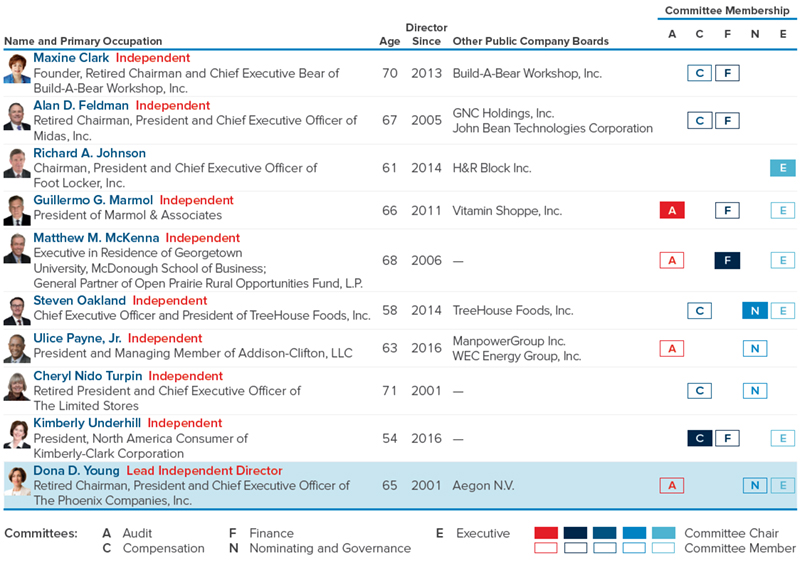
| Committee Membership(2) | ||||||||||||||
| Name and Primary Occupation | Age(1) | Director Since | Independent | Other Public Company Boards | A | F | C | N | E | |||||
| Maxine Clark | ||||||||||||||
| Founder, Retired Chairman and Chief Executive Bear of Build-A-Bear Workshop, Inc. | 69 | 2013 |  | Build-A-Bear Workshop, Inc. |  |  | ||||||||
| Alan D. Feldman | ||||||||||||||
| Retired Chairman, President and Chief Executive Officer of Midas, Inc. | 66 | 2005 |  | GNC Holdings, Inc. John Bean Technologies Corporation |  |  |  | |||||||
| Richard A. Johnson | ||||||||||||||
| Chairman, President and Chief Executive Officer of Foot Locker, Inc. | 60 | 2014 |  | H&R Block Inc. |  | |||||||||
| Guillermo G. Marmol | ||||||||||||||
| President of Marmol & Associates | 65 | 2011 |  | Vitamin Shoppe, Inc. |  |  |  | |||||||
| Matthew M. McKenna | ||||||||||||||
| Executive in Residence of Georgetown University, McDonough School of Business | 67 | 2006 |  | None |  |  |  | |||||||
| Steven Oakland | ||||||||||||||
| Chief Executive Officer and President of TreeHouse Foods, Inc. | 57 | 2014 |  | TreeHouse Foods, Inc. |  |  |  | |||||||
| Ulice Payne, Jr. | ||||||||||||||
| President and Managing Member of Addison-Clifton, LLC | 62 | 2016 |  | ManpowerGroup Inc. The Northwestern Mutual Life Insurance Company WEC Energy Group, Inc. |  |  | ||||||||
| Cheryl Nido Turpin | ||||||||||||||
| Retired President and Chief Executive Officer of the Limited Stores | 70 | 2001 |  | None |  |  | ||||||||
| Kimberly Underhill | ||||||||||||||
| Global President of Kimberly-Clark Professional | 53 | 2016 |  | None |  |  | ||||||||
| Dona D. Young(3) | ||||||||||||||
| Retired Chairman, President and Chief Executive Officer of The Phoenix Companies, Inc. | 64 | 2001 |  | Aegon N.V. |  |  |  | |||||||
 | |
 | |

|  |
 1 |
Proxy Statement Summary

Attendance
|
|
Diversity*
Independence
|
| |
|
9out of10directors are independent

All directors are independent, except the CEO
Diversity
Our directors represent a range of backgrounds and experience. The majority are women or ethnically diverse. Our Nominating and Corporate Governance Committee (the “Nominating and Governance Committee”) is focused on ensuring continued diversity on the Board—in terms of gender, age, ethnicity, skills, business experience, service on our Board and the boards of other organizations, and viewpoints—during refreshment activities by requiring that candidate pools include diverse individuals meeting the recruitment criteria.
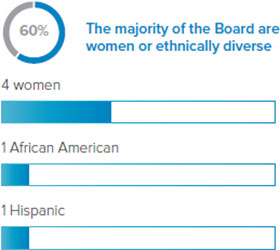
Tenure
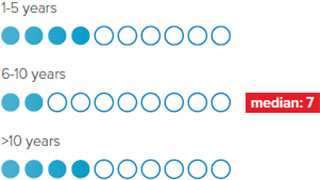
Directors with varied tenure contribute to a range of perspectives and ensure we transition knowledge and experience from longer-serving members to those newer to our Board. We have a good mix of new and longer-serving directors.
Refreshment

3 New Directors Added Over Past Five Years
3 Directors Retired Over Past Five Years
Age


| Foot Locker, Inc. |
Proxy Statement Summary
Environmental, Social, and Governance Highlights
The Company and the Board are focused on corporate social responsibility. We continuously look for new and better ways to foster a diverse and inclusive work environment, engage our surrounding communities, improve employee safety, and minimize our environmental impact, all while creating value for our shareholders. Below are some recent highlights of our diversity and sustainability initiatives.
 | |||||||
|
| ||||||
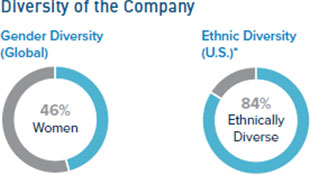 | 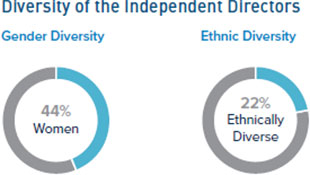 | ||||||
| ● | We have several women in senior leadership roles, including the Chief Financial Officer, Chief Human Resources Officer, General Counsel and Secretary, Chief Accounting Officer, Vice President—Global Total Rewards, and Vice President and General Manager, Foot Locker Pacific | ● | Our independent directors represent a diverse range of backgrounds and experience | ||||
| ● | We strive to have a workforce that reflects the diversity of qualified talent that is available in the markets that we serve | ||||||
 | |||||||
| Raised and donated over$9 millionfor scholarships since 2004, plus footwear and apparel donations to several organizations | ● | U.S. non-store employees permitted paid time-off for volunteering in their communities | |||||
 | |||||||
 | 
|
Summary

Named Executive Officers
Fiscal 2017 Results
We were a highly profitable company in 2017, and despite the challenges and disruptive retail environment we faced during the year, we produced some notable achievements. Highlights include the following:
 | ||||||
* U.S. workforce represents 74% of global workforce.
| 2019 Proxy Statement |  3 |
Proxy Statement Summary
Recognition

For additional information, seeEnvironmental, Social, and Governance Highlightsbeginning on page 20.
Fiscal 2018 Results
We built positive momentum and improved our financial results in 2018. Highlights include the following:

| * | A reconciliation to GAAP is provided beginning on |
 
| |  |
Proposal 1: Election of Directors
ThereThere are currently 1110 directors on our Board. Jarobin Gilbert, Jr. will be retiring when his term expires at the conclusion of this Annual Meeting, and theThe Board has fixed the number of directors at 10 effective at such time.10. All current directors other than Mr. Gilbert are standing for election for a one-year term at this meeting.
We have refreshed our Board over the past sevenfive years, as seventhree highly-qualified directors were added to the Board and sixthree directors will have retired as of the Annual Meeting.retired. We believe that the Board possesses the appropriate mix of diversity in terms of gender, age, ethnicity, skills, business experience, service on our Board and the boards of other organizations, and viewpoints.
Maxine Clark, Alan D. Feldman, Richard A. Johnson, Guillermo G. Marmol, Matthew M. McKenna, Steven Oakland, Ulice Payne, Jr., Cheryl Nido Turpin, Kimberly Underhill, and Dona D. Young will be considered for election as directors to serve for one-year terms expiring at the 20192020 Annual Meeting. Each nominee has been nominated by the Board for election and has consented to serve. If, prior to the 20182019 Annual Meeting, any nominee is unable to serve, then the persons designated as proxies for this meeting (Sheilagh M. Clarke, John A. Maurer, and Lauren B. Peters) will have full discretion to vote for another person to serve as a director in place of that nominee unlessor the Board decides tomay reduce the size of the Board.
The Nominating and Corporate Governance Committee (the “Nominating and Governance Committee”) reviewed and updated the director skill-set matrix in light of the Company’s long-term strategic plan and evaluated the directors’ skills, experience, and qualifications under the updated matrix, which is shown beginning on Page 7.
page 11.
The Board, acting through the Nominating and Governance Committee, considers its members, including those directors being nominated for reelection to the Board at the 20182019 Annual Meeting, to be highly qualified for service on the Board due to a variety of factors reflected in each director’s education, areas of expertise, and experience serving on the boards of directors of other organizations during the past five years. Generally, the Board seeks individuals with broad-based experience and who have the background, judgment, independence, and integrity to represent the shareholders in overseeing the Company’s management in their operation of the business. Within this framework, specific items relevant to the Board’s determination for each director are listed in each director’s biographical information beginning on Page 2.page 6. The ages shown are as of April 13, 2018.12, 2019. There are no family relationships among our directors or executive officers.

The Board recommends that shareholders voteFORthe election of each of theten identified nominees to the Board.
| ✓ | The Board recommends that shareholders voteFOR the election of each of the ten identified nominees to the Board. |
 |  
|
Proposal 1: Election of Directors
| Maxine Clark |
 |
Proposal 1

Independent Director Age: 70
|
| |
| Ms. Clark served as Chief Executive Bear of Build-A-Bear Workshop, Inc. (retail merchants) from her founding the company in 1997 until her retirement in June 2013, and served as its Chairman from April 2000 until November 2011. Following her retirement, Ms. Clark served as a consultant to Build-A-Bear Workshop until January 2014. Ms. Clark is a director of Build-A-Bear Workshop, Inc. Ms. Clark also serves as Chief Executive Officer of the Clark-Fox Family Foundation, Inspirator of The Delmar DivINe (real estate initiative for community development in St. Louis), Managing Partner of Prosper Women’s Capital, and Executive in Residence of Washington University in St. Louis, John M. Olin School of Business. She serves as chairwoman of the St. Louis Regional Educational and Public Television Commission (KETC/-Channel 9 Public Television)
| Ms. Clark has extensive experience in both domestic and international retailing, including founding and leading Build-A-Bear Workshop, serving as President of Payless ShoeSource, Inc., and serving for 19 years as an executive of The May Department Stores Company. She adds significant experience to our Board in strategic planning, real estate, digital technology, and marketing. Her retail and business background, as well as her financial expertise, are particularly useful for her service as a member of the Finance and Strategic Planning Committee (the “Finance Committee”). | |

Alan D. Feldman
| ||
 | Independent Director Age: 67
|
|
| Mr. Feldman served as Chairman, President and Chief Executive Officer of Midas, Inc. (automotive repair and maintenance services) from May 2006 to April 2012, and as President and Chief Executive Officer of Midas, Inc. from January 2003 to April 2006. He was an independent consultant from March 2002 to January 2003. Mr. Feldman previously served as an executive at PepsiCo, Inc., Pizza Hut, Inc., and McDonald’s Corporation. Mr. Feldman is a director of John Bean Technologies Corporation and GNC Holdings, Inc., the Chair of the Foundation Board of the University of Illinois, and a member of the Governing Council of Good Samaritan Hospital. He was a director of Midas, Inc. from January 2003 to April 2012.
| Mr. Feldman is a recognized business leader with a broad base of experience in franchised retail operations, brand management, and customer relations. He previously served as Chairman, President and Chief Executive Officer of Midas, Inc. and currently serves on the boards of two other public companies, John Bean Technologies Corporation and GNC Holdings, Inc. Mr. Feldman’s leadership skills, retail knowledge, financial expertise, and executive experience provide particularly useful background for his service as a member of the Finance Committee and | |
 |
 |

| |  |
Proposal 1

Proposal 1: Election of Directors
Richard A. Johnson
| ||
 | Chairman, President and Chief Executive Age: 61
|
|
| Mr. Johnson has served as the Company’s Chairman of the Board since May 2016, and President and Chief Executive Officer since December 2014. Mr. Johnson served as Executive Vice President and Chief Operating Officer from May 2012 to November 2014. He served as Executive Vice President and Group President-Retail Stores from July 2011 to May 2012; President and Chief Executive Officer of Foot Locker U.S., Lady Foot Locker, Kids Foot Locker, and Footaction from January 2010 to June 2011; President and Chief Executive Officer of Foot Locker Europe from August 2007 to January 2010; and President and Chief Executive Officer of Footlocker.com/Eastbay from April 2003 to August 2007. Mr. Johnson has been a director of H&R Block Inc. since September 2015 and was previously a director of Maidenform Brands, Inc. from January 2013 to October 2013.
| Mr. Johnson has extensive experience as a retail company executive, including | |

Guillermo G. Marmol
| ||
 | Independent Director Age: 66
|
|
| Mr. Marmol has served as President of Marmol & Associates (consulting firm that provides advisory services and investment capital to early stage technology companies) since March 2007 and, prior to that, from October 2000 to May 2003. He served as Division Vice President and a member of the Executive Committee of Electronic Data Systems Corporation (global technology services company) from June 2003 to February 2007, and as a director and Chief Executive Officer of Luminant Worldwide Corporation (internet professional services company) from July 1998 to September 2000. He served as Vice President and Chair of the Operating Committee of Perot Systems Corporation (information technology and business solutions company) from December 1995 to June 1998. He began his career at McKinsey & Company (management consulting firm) from 1990 to 1995, rising to Senior Partner, and was a leader of the organization and business process redesign practices. Mr. Marmol is a director of Vitamin Shoppe, Inc. and
Principal Solar Inc. | Mr. Marmol has a significant background in information technology and systems, which continues to be highly important to the Company as we enhance our technology and systems and build a more powerful digital business to connect with our customers. He also serves as a director and Chair of the Nomination and Governance Committee of another public company, Vitamin Shoppe, Inc. Through his long tenure as a management consultant focusing on strategic analysis and business processes, he brings valuable knowledge and expertise to his service on the Board, as Chair of the Audit Committee and as a member on the Finance Committee. | |
 | 
|
 |
Proposal 1

| 2019 Proxy Statement |  7 |
Proposal 1: Election of Directors
| Matthew M. McKenna
| ||
 | Independent Director Age: Director since:2006
|
|
| Mr. McKenna has served as Executive in Residence of Georgetown University’s McDonough School of Business since February
| Mr. McKenna has extensive | |

Steven Oakland
| ||
 | Independent Director Age: 58
|
|
| Mr. Oakland has served as Chief Executive Officer and President of TreeHouse Foods, Inc. (manufacturer of packaged foods and beverages) since March 2018. He previously served as Vice Chair and President, U.S. Food and Beverage of The J.M. Smucker Company (“Smucker’s”) (manufacturer of packaged foods and beverages) from May 2016 to March 2018; President, Coffee and Foodservice of Smucker’s from April 2015 to April 2016; President, International Food Service of Smucker’s from May 2011 to March 2015; and President, U.S. Retail-Smucker’s Jif, and Hungry Jack from August 2008 to May 2011. He also serves on the board of MTD Products, Inc., a privately-held manufacturing
Foster Farms, a privately-held poultry business. | Mr. Oakland brings to our Board a broad-based business background and extensive experience in domestic and international consumer products operations, with particular strength in customer engagement, marketing, brand-building, and strategic planning. Additionally, Mr. Oakland is actively involved in management resources issues and governance matters as the chief executive of a public company, providing him with relevant expertise as a member of the Compensation Committee and Chair of the Nominating and Governance Committee. Mr. Oakland also has risk management, business development, and mergers and acquisitions experience. | |
 |
 
| |  |
Proposal 1

Proposal 1: Election of Directors
Ulice Payne, Jr.
| ||
 | Independent Director Age: 63
|
|
| Mr. Payne has served as President and Managing Member of Addison-Clifton, LLC (global trade compliance advisory services provider) since May 2004. He previously served as
The Marcus Corporation from 1996 to 2000. | Mr. Payne brings to our Board significant managerial, operational, financial, public service, and global experience as a result of the many senior positions he has held, including as President and Managing Member of Addison-Clifton, LLC, President and Chief Executive Officer of the Milwaukee Brewers Baseball Club, Managing Partner of Foley & Lardner, LLP, and the Wisconsin Commissioner of Securities. He also serves as a director of | |

Cheryl Nido Turpin
| ||
 | Independent Director Age: 71 Director since: 2011 |
|
| Ms. Turpin served as President and Chief Executive Officer of
| Ms. Turpin brings to our Board long experience as a retail executive, most recently as President and Chief Executive Officer of The Limited Stores, where she worked in a multi-divisional retail structure similar to our Company. She previously served as a director of two other public companies, The Warnaco Group, Inc. and Stage Stores, Inc., and she served as chair of the compensation committees of those companies. Her | |
 |
 |  
|
Proposal 1: Election of Directors
| Kimberly Underhill |
 |
Proposal 1

Independent Director Age: 54 Director since: 2016 |
| |
| Ms. Underhill has served as
| Ms. Underhill brings to our Board a broad-based business background and extensive experience in domestic and international consumer products operations, with particular strength in marketing, brand-building, strategic planning, and international business development. Additionally, Ms. Underhill is actively involved in management resources issues as a senior executive of a public company, which provides relevant expertise to both our Compensation Committee, of which she is Chair, and Finance Committee, of which she is a member. Through her senior executive position at Kimberly-Clark, Ms. Underhill also has significant international and business development experience. | |

Dona D. Young
| ||
 | Independent Lead Director Age: 65 Director since: 2001 |
|
| Mrs. Young retired in April 2009 as Chairman, President and Chief Executive Officer of The Phoenix Companies, Inc. (at the time an insurance and asset management company) after a nearly 30-year career. She currently engages in independent strategic advising and consulting, with a focus on corporate social responsibility and board governance issues, and CEO coaching and counseling. She is a member of the Supervisory Board of Aegon N.V. (multinational life insurance, pension, and asset management company), a director of the National Association of Corporate Directors (NACD), a trustee of the Saint James School in Saint James, Maryland, and a
| Mrs. Young brings significant financial, | |
 |
 
| |  |
Proposal 11: Election of Directors
Summary of Director Qualifications and Experience and Demographic Matrix
We believe that our slate of director nominees possesses the appropriate mix of diversity in terms of gender, age, ethnicity, skills, business experience, service on our Board and the boards of other organizations, and viewpoints. We have refreshed our Board over the past five years, as three highly-qualified directors were added to the Board, and three directors retired. Each director is individually qualified to make unique and substantial contributions. Collectively, our directors’ diverse viewpoints and independent-mindedness enhance the quality and effectiveness of Board deliberations and decision making. This blend of qualifications, attributes, and tenure results in highly effective leadership and is summarized below.
| Knowledge, Skills, and Experience | ||||||||||||||||||
| Leadership | ||||||||||||||||||
 | Chief Executiveexperience is important because directors who have served as CEOs of public or substantial privately-held or non-profit companies have experience working, communicating, and engaging with a variety of important stakeholder groups, including shareholders, bondholders, and investment analysts |  |  | ● |  |  |  |  |  |  | ||||||||
| Strategy | ||||||||||||||||||
 | Broad-Based Businessexpertise provides a depth of experience to leverage in evaluating issues, and making business judgments |  |  |  |  |  |  |  |  |  |  |  | ||||||
 | Digital and Channel Connectivityexperience is important to the Company as we build a more powerful digital experience for our customers |  | ● | ● |  |  | ||||||||||||
 | Public Serviceexperience is relevant to the Company as it is affected by government actions | ● | ● | |||||||||||||||
 |  | |||||||||||||||||
 | Information Securityexperience is relevant given the importance of protecting both the Company’s and our customers’ information |  |  | |||||||||||||||
 | Internationalexperience is important in understanding and reviewing our business and strategy outside of the United States, particularly in Europe |  |  |  |  |  |  |  | ||||||||||
 |  | |||||||||||||||||
 | Retail, Brand Marketing, and Social Mediaexperience gives directors |  |  |  |  |  |  | |||||||||||
 | Strategic Investmentsexperience is important in evaluating our financial statements and investment strategy | ● | ● | ● | ||||||||||||||
 | Strategic Planning and Analysisexperience provides a practical understanding of assessing, developing, and implementing the metrics of our long-term financial objectives and strategic priorities |  |  | ● | ● | ● | ● | ● |  |  |  |  |  |  |  | |||
 |  |  |  | |||||||||||||||
 |  | |||||||||||||||||
 | Supply Chainexperience |  |  |  |  |  |  |  |  | |||||||||
 |  |  |  |  |  |  |  |  |  | |||||||||
 |  |  |  |  |  | |||||||||||||
 |  |  |  |  |  | |||||||||||||
 |  
|
Proposal 1: Election of Directors
| Knowledge, Skills, and Experience | Clark | Feldman | Johnson | Marmol | McKenna | Oakland | Payne | Turpin | Underhill | Young | |
 | Technology and Systemsexperience is important given the importance of technology to the retail marketplace, our internal operations, and our customer engagement initiatives | ● | ● | ||||||||
 | Youth Culture/Target Marketexperience is important to understand our business and strategy as our brands keenly focus on their target customers, particularly youth culture | ● | ● | ● | ● | ||||||
| Governance | |||||||||||
 | Accounting or Financialexpertise gained from experience as a CEO, audit professional, or finance executive is important because it assists our directors in understanding and overseeing our financial reporting and internal controls | ● | ● | ● | ● | ● | ● | ● | ● | ||
 | Business Development / Mergers and Acquisitionsexperience is important because it helps in assessing potential growth opportunities | ● | ● | ● | ● | ● | ● | ● | ● | ● | |
 | Environmental, Social, and Governanceexperience is important because it supports our goals of strong Board and management accountability, transparency, and protection of shareholder interests | ● | ● | ● | ● | ● | ● | ● | |||
 | Risk Managementexperience is helpful to the Board’s role in overseeing the risks facing the Company | ● | ● | ● | ● | ● | ● | ||||
| Demographic Background | |||||||||||
| Board Tenure (Year Joined) | 2013 | 2005 | 2014 | 2011 | 2006 | 2014 | 2016 | 2001 | 2016 | 2001 | |
| Years | 6 | 14 | 5 | 8 | 13 | 5 | 3 | 18 | 3 | 18 | |
| Gender | ● | ● | ● | ● | ● | ● | |||||
| Male | ● | ● | ● | ● | |||||||
| Female | |||||||||||
| Age (at April 12, 2019) | |||||||||||
| Years old | 70 | 67 | 61 | 66 | 68 | 58 | 63 | 71 | 54 | 65 | |
| Race/Ethnicity | |||||||||||
| African American | ● | ||||||||||
| Hispanic | ● | ||||||||||
| White | ● | ● | ● | ● | ● | ● | ● | ● | |||
| Number of Other Public Company Boards | 1 | 2 | 1 | 1 | — | 1 | 2 | — | — | 1 | |
 12 | Foot Locker, Inc. |
The Board is committed to good corporate governance and has adopted Corporate Governance Guidelines and other policies and practices to guide the Board and senior management.
We believe that the Board possesses the appropriate mix of diversity in terms of gender, age, ethnicity, skills, business experience, service on our Board and the boards of other organizations, and viewpoints. We have refreshed our Board over the past seven years, as seven highly-qualified directors were added to the Board, and six directors will have retired as of this Annual Meeting.Directors
Corporate Governance Guidelines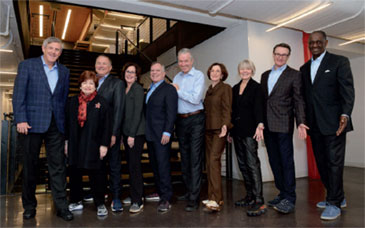
Our By-Laws provide for a Board consisting of between 7 and 13 directors. The exact number of directors is determined from time to time by the entire Board. The Board has fixed the number of directors at 10, and there are currently 10 directors on our Board.
Directors’ Independence
A director is not considered independent under New York Stock Exchange (“NYSE”) rules if he or she has a material relationship with the Company that would impair his or her independence. In addition to the independence criteria established by the NYSE, the Board has adopted Corporate Governance Guidelines. The Board periodically reviewscategorical standards to assist it in making its independence determinations regarding individual directors. These categorical standards are contained in the guidelines and revises them, as appropriate. The Corporate Governance Guidelines, which are availableposted on the corporate governance section of the Company’s corporate website atwww.footlocker.com/corpgovfootlocker.com/corp. You may also obtain a printed copy of the guidelines by writing to the Secretary at the Company’s headquarters.
The Company has adopted Global Sourcing Guidelines that set out standards applicable to the production of all products sold in our stores. The Company periodically reviews the guidelines and revises them, as appropriate. The Global Sourcing Guidelines are available on the corporate governance section of the Company’s corporate website atwww.footlocker.com/corpgov. You may also obtain a printed copy of the guidelines by writing to the Secretary at the Company’s headquarters.
The Board has adopted chartersdetermined that the following categories of relationships are immaterial for purposes of determining whether a director is independent under the NYSE listing standards:
| Categorical Relationship | Description |
| Investment Relationships with the Company | A director and any family member may own equities or other securities of the Company. |
| Relationships with Other Business Entities | A director and any family member may be a director, employee (other than an executive officer), or beneficial owner of less than 10% of the shares of a business entity with which the Company does business, provided that the aggregate amount involved in a fiscal year does not exceed the greater of $1 million or 2% of either that entity’s or the Company’s annual consolidated gross revenue. |
| Relationships with Not-for-Profit Entities | A director and any family member may be a director or employee (other than an executive officer or the equivalent) of a not-for-profit organization to which the Company (including the Foot Locker Foundation) makes contributions, provided that the aggregate amount of the Company’s contributions in any fiscal year do not exceed the greater of $1 million or 2% of the not-for-profit entity’s total annual receipts. |
We individually inquire of each of our directors and executive officers about any transactions in which the Company and any of these related persons or their immediate family members are participants. We also make inquiries within the Company’s records for information on any of these kinds of transactions. Once we gather the information, we then review all relationships and transactions of which we are aware in which the Company and any of our directors, executive officers, their immediate family members or five-percent shareholders are participants to determine, based on the facts and circumstances, whether the related persons have a direct or indirect material interest. The General Counsel’s office coordinates the related person transaction review process. The Nominating and Governance Committee reviews any reported transactions involving directors and their immediate family members in making its recommendation to the Board on the independence of the directors. In approving, ratifying, or rejecting a related person transaction, the Nominating and Governance Committee considers such
| 2019 Proxy Statement |  13 |
Corporate Governance
information as it deems important to determine whether the transaction is on reasonable and competitive terms and is fair to the Company. The Company’s written policies and procedures for related person transactions are included within both the Corporate Governance Guidelines and the Code of Business Conduct. There were no related person transactions in 2018.
The Board, upon the recommendation of the Nominating and Governance Committee, has determined that the following directors are independent under NYSE rules because they have no material relationship with the Company that would impair their independence:

Jarobin Gilbert, Jr. served as a director of the Company during 2018 until his retirement from the Board in May 2018. The Board determined that Mr. Gilbert was independent under NYSE rules through the end of his term as a director because he had no material relationship with the Company that would impair his independence.
In making its independence determination, the Board reviewed recommendations of the Nominating and Governance Committee and considered Dona D. Young and Ulice Payne, Jr.’s relationships as directors of companies with which we do business. The Board has determined that these relationships meet the categorical standard for Relationships with Other Business Entities and are immaterial with respect to determining independence.
The Board has determined that all members of the Audit Committee, the Compensation Committee, the Finance Committee, and the Nominating and Governance Committee. Copies ofCommittee are independent as defined under the charters for these committees are available on the corporate governance section of the Company’s corporate website atwww.footlocker.com/corpgov. You may also obtain printed copies of these charters by writing to the Secretary at the Company’s headquarters.
In February 2018, our Board adopted amendments to our By-Laws to implement proxy access. Under our proxy access bylaw, a shareholder, or a group of up to 20 shareholders, owning at least 3% of the Company’s outstanding common stock continuously for at least three years as of the date of the notice of nomination, may nominate and include in the Company’s proxy materials director nominees constituting up to two individuals or 20% of the Board, whichever is greater (subject to certain limitations set forth in the By-Laws), provided that the shareholder(s) and nominee(s) satisfy the requirements specified in the By-Laws.
The Board spent significant time evaluating the adoption of a proxy access bylaw. In crafting the bylaw, the Board considered a variety of views on proxy access, including feedback received from extensive discussions with our shareholders and independent advisors with expertise in corporate governance. A number of our shareholders have expressed support for proxy access provisions,NYSE listing standards and the Board believes the bylaw is in the best interest of all shareholders.
Majority Voting in the Election of Directors
At our 2017 Annual Meeting, shareholders approved an amendment to our By-Laws to implement a majority voting standard in uncontested director elections. Our By-Laws previously had provided for a plurality vote standard in director elections. Beginning with our 2018 Annual Meeting, directors must be elected by a majority of the votes cast in elections for which the number of

|  |
Corporate Governance
nominees for election does not exceed the number of directors to be elected. A plurality vote standard will continue to apply to contested elections where the number of nominees exceeds the number of directors to be elected. Our Corporate Governance Guidelines provide that any incumbent director who does not receive a majority of the votes cast in an uncontested election is required to tender his or her resignation for considerationindependence standards adopted by the Nominating and Governance Committee. The Nominating and Governance Committee will make a recommendation to the Board whether to accept or reject the resignation, or whether other action should be taken. In determining its recommendation to the Board, the Nominating and Governance Committee will consider all factors that it deems relevant and, following such determination, the Company will promptly disclose publicly the Board’s decision, including, if applicable, the reasons for rejecting the tendered resignation.
The Board believes that a significant majority of its members should be independent, as determined by the Board based on the criteria established by the New York Stock Exchange (the “NYSE”). Each year, the Nominating and Governance Committee reviews any relationships between outside directors and the Company that may affect independence. Currently, one of the eleven members of the Board serves as an officer of the Company, and the remaining ten directors are independent under the criteria established by the NYSE. Please see Pages 16 through 17 for more information regarding director independence.
As a general principle, the Board believes that the periodic rotation of committee assignments on a staggered basis is desirable and provides an opportunity to foster diverse perspective and develop breadth of knowledge within the Board. In 2017, Ms. Clark rotated off of the Audit Committee and onto the Compensation Committee and Mrs. Young rotated off of the Compensation Committee and onto the Audit Committee.
The Board believes that when the positions of Chairman and Chief Executive Officer are held by the same person, an independent lead director should be appointed.
The Lead Director’s responsibilities include:
 | 
|
Corporate Governance
The Board considers the periodic rotation of the Lead Director from time to time, taking into account experience, continuity of leadership, and the best interests of the Company.
Dona D. Young currently serves as the Lead Director. The Board believes that Mrs. Young is well suited to serve as Lead Director, given her business, financial, and governance background, as well as her more than seventeen years of service on our Board.
Our Board evaluates, from time to time as appropriate, whether the same person should serve as Chairman and Chief Executive Officer, or whether the positions should be held by different persons, in light of all relevant facts and circumstances and what it considers to be in the best interests of the Company and our shareholders. Since May 2016, the positions of Chairman and Chief Executive Officer have been held by Richard A. Johnson, with Dona D. Young serving as independent Lead Director. The Board has utilized various leadership structures since 2001,2010, as shown below:
| December 2014 | May 2015 | May 2016 | |
| Positions combined, with an independent Lead Director | |||
| Positions separated, with the former Chairman and Chief Executive Officer serving as | |||
| Executive Chairman, and an independent director serving as Lead Director | |||
| Positions separated, with an independent director serving as Non-Executive Chairman | |||
| Positions combined, with an independent Lead Director |
| The Board believes that, based on the Company’s current facts and circumstances, its Board leadership structure is appropriate. |
Lead Director
The Board believes that, based onparticularly because the Company’s current factspositions of Chairman and circumstances, its Board leadership structureChief Executive Officer are held by the same person, the appointment of an independent lead director is appropriate.
The Lead Director’s responsibilities include:
 14 | Foot Locker, Inc. |
Corporate Governance
The Board considers the periodic rotation of Non-Management Directorsthe Lead Director from time to time, taking into account experience, continuity of leadership, and the best interests of the Company.
Dona D. Young currently serves as the Lead Director. The Board believes that Mrs. Young is well suited to serve as Lead Director, given her business, financial, and governance background, as well as her more than eighteen years of service on our Board.
Director On-Boarding and Education
We have an on-boarding program for new directors that is intended to educate a new director on the Company and the Board’s practices. During the first year of the director’s service, the newly-elected director meets with the Company’s Chief Executive Officer, Chief Financial Officer, Chief Human Resources Officer, General Counsel and Secretary, and other members of senior management, to review the Company’s business operations, financial matters, strategy, investor relations, risk management, corporate governance, composition of the Board and its committees, and succession and development plans. Additionally, he or she visits our stores near the Company’s New York headquarters, and elsewhere, with senior management for an introduction to store operations. During this first year, new directors periodically meet with the Lead Director and with the committee chairs for an immersion into the work of the committees.
The second phase of the on-boarding program commences approximately 18 months after the director joins the Board and is specifically tailored to the individual director, taking into consideration his or her experience as a director of other public companies, the committees of our Board on which he or she serves, and areas of our business and strategy that the director would like to explore more thoroughly with management. For example, during this second phase of the program, directors participate in enhanced discussions in the areas of customer data, retail accounting and operations, and risk management, and meet with key talent. Regular check-ins with the Lead Director continue throughout the on-boarding program.
We also provide the Board with educational training, using both internal and external resources, in connection with each quarterly Board meeting and provide outside speakers on relevant topics during Board dinners. We encourage all directors to attend other continuing education programs to maintain their expertise and provide feedback to the other directors on these programs.
Mandatory Resignation or Retirement
The Board has established a policy whereby a non-employee director is required to advise the Chair of the Nominating and Governance Committee of any change to his or her principal employment. If requested by the Chair, after consultation with the members of the Committee, the director will submit a letter of resignation to the Chair of the Committee, and the Committee would then meet to consider whether to accept or reject the resignation.
The Corporate Governance Guidelines also require that directors retire from the Board at the annual meeting of shareholders following the director’s 72nd birthday.
Corporate Governance Guidelines
The Board has responsibility for establishing broad corporate policies, reviewing significant developments affecting the Company, overseeing the business strategy, and monitoring the general performance of the Company.
The Board has adopted Corporate Governance Guidelines. The Board periodically reviews the guidelines and revises them, as appropriate. The Corporate Governance Guidelines are available on the corporate governance section of the Company’s corporate website atfootlocker.com/corp. You may also obtain a printed copy of the guidelines by writing to the Secretary at the Company’s headquarters.
| 2019 Proxy Statement |  15 |
Corporate Governance
Board Attendance
The Board held six meetings during 2018. All of our directors attended at least 75% of the aggregate of the meetings of the Board and of the committees on which they served in 2018.
The Board holds regularly scheduled executive sessions of non-management directors in conjunction witheach quarterly Board meeting. Dona D. Young, as Lead Director, presides at these executive sessions.
Directors are expected to attend annual meetings of shareholders. The annual meeting is normally scheduled on the same day as a quarterly Board meeting. In 2018, all of the directors attended the annual meeting.
Retention of Outside Advisors
The Board and all of its committees have authority to retain outside advisors and consultants that they consider necessary or appropriate in carrying out their respective responsibilities. The independent accountants are retained by, and report directly to, the Audit Committee. In addition, the Audit Committee is responsible for overseeing the qualifications, performance, and compensation of the internal auditors to which the Company has outsourced in part. Similarly, the consultant retained by the Compensation Committee to assist in the evaluation of senior executive compensation reports directly to that committee.
Board Evaluations
Each year, the Board and its committees engage in a robust evaluation process consistent with the Board’s goal of continuous improvement. The Nominating and Governance Committee oversees the evaluation process and reviews the procedures, which may vary from year to year, in advance of each year’s evaluation. The process is designed to elicit candid feedback regarding the areas in which the Board and its committees could improve their effectiveness and utilizes surveys, individual interviews, and action planning. For
In addition, in 2018, the 2018Board enhanced its evaluation process the Board has engagedand undertook a 360-degree peer evaluation process facilitated by an independent third party to facilitateparty. Each director completed an evaluation and individual director peer assessments.
Board Members’ Attendance at Annual Meetings
Directors are expected to attend annual meetings of shareholders.interview with the third party. The annual meeting is normally scheduled on the same day as a quarterly Board meeting. In 2017, allChair of the directors attended the annual meeting.

|  |
CorporateNominating and Governance
Director On-Boarding Committee and Education
We have an on-boarding program for new directors that is intended to educate a new director on the Company and the Board’s practices. Over the course of the one-year on-boarding program, the newly-elected director meets with the Company’s Chief Executive Officer, Chief Financial Officer, General Counsel and Secretary, and other members of senior management, to review the Company’s business operations, financial matters, strategy, investor relations, risk management, corporate governance, composition of the Board and its committees, and succession and development plans. Additionally, he or she visits our stores near the Company’s New York headquarters, and elsewhere, with senior management for an introduction to store operations. During the on-boarding year, new directors periodically meet with the Lead Director and with the committee chairs for a deep dive into the workeach received copies of the committees. We also provide the Boardcompleted evaluations. The Lead Director met separately with educational training from time to time on subjects applicable to the Boardeach director, and the Company, including with regard to retailing, accounting, financial reporting, and corporate governance, using both internal and external resources, and we encourage all directors to attend other continuing education programs to maintain their expertise.
Payment of Directors’ Fees in Stock
The non-employee directors receive one-half of their annual retainer fees, including committee chair retainer fees, in shares of the Company’s common stock, par value $0.01 per share (“Common Stock”), with the balance payable in cash. Directors may elect to receive up to 100% of their annual retainer fees in stock.
The Board has established a policy in its Corporate Governance Guidelines that directors retire from the Board at the annual meeting of shareholders following the director’s 72nd birthday.
Change in a Director’s Principal Employment
The Board has established a policy whereby a director is required to advise the Chair of the Nominating and Governance Committee of any changemet with the Lead Director, to his or her principal employment. If requested bydiscuss the Chairresults of the Committee, after consultation with the members of the Committee, the director will submit a letter of resignationindividual evaluations. The Board plans to the Chair of the Committee, and the Committee would then meetconduct peer evaluations approximately every two to consider whether to accept or reject the resignation.three years.
The Board engages in an effective planning process to identify, evaluate, and select potential successors to the Chief Executive Officer and other members of senior management. The Chief Executive Officer reviews senior management succession planning with the Board. Each director has complete and open access to any member of management. Members of management are invited regularly to make presentations at Board and committee meetings and meet with directors in informal settings to allow the directors to form a more complete understanding of the executives’ skills and character.
The Board has oversight responsibilities regarding risks that could affect the Company. This oversight isconducted primarily through the Audit Committee. The Audit Committee has established procedures for reviewing the Company’s risks. These procedures include regular risk monitoring by management to update current risks and identify potential new and emerging risks, quarterly risk reviews by management with the Audit Committee, and an annual risk report to the full Board. In addition, the Audit Committee receives regular briefings from our Chief Information and Customer Connectivity Officer, Chief Financial Officer, Chief Accounting Officer, General Counsel, head of our internal audit function, and outside experts on cybersecurity risks and cyber risk oversight. During these meetings, the Audit Committee and management discuss these risks, risk management activities and efforts, best practices, lessons learned from incidents at other companies, the effectiveness of our security measures, and other related matters. The Audit Committee Chair reports on the committee’s meetings, considerations, and actions to the full Board at the next Board meeting following each committee meeting. Also,
 | 
|
Corporate Governance
the Compensation Committee considers risk in relation to the Company’s compensation policies and practices. The Compensation Committee’s independent compensation consultant provides an annual report to the committee on risk relative to the Company’s compensation programs.
The Company believes that this process for risk oversight is appropriate in light of the Company’s business, size, and active senior management participation, including by the Chief Executive Officer, in managing risk and holding regular discussions on risk with the Audit Committee, the Compensation Committee, and the Board.
The Board has adopted Stock Ownership Guidelines applicable to the Board, the Chief Executive Officer, and other covered executives. The Guidelines are as follows:
| Covered Position | Stock Ownership Guidelines | |
| Non-employee Director | 4xAnnual Retainer Fee (both Cash and Equity)
| |
| Chief Executive Officer | 6xAnnual Base Salary
| |
| Executive Vice President | 3xAnnual Base Salary  | |
Senior Vice | ||
| President; Senior Vice President and General Manager | 2xAnnual Base Salary
| |
Corporate Vice President; Vice President and General Manager | 0.5xAnnual Base Salary
|
 16 | Foot Locker, Inc. |
Corporate Governance
Shares of unvested restricted stock, unvested restricted stock units (“RSUs”), and deferred stock units (“DSUs”) are counted towards ownership for purposes of the Stock Ownership Guidelines. Performance-based RSUs (“PBRSUs”) are counted once earned. Stock options and shares held through the Foot Locker 401(k) Plan are disregarded in calculating ownership for purposes of the Stock Ownership Guidelines.ownership.
Directors, the Chief Executive Officer, and other covered executives are required to be in compliance within five years of becoming subject to these guidelines. In the event of any increase in the required ownership level, whether as a result of an increase in the annual retainer fee or base salary or an increase in the required ownership multiple, the target date for compliance with the increased ownership guideline would be five years after the effective date of such increase.
All executives and continuing directors who were required to be in compliance with the guidelines as of the end of the 20172018 fiscal year are in compliance. The Company measures compliance with the guidelines at the end of the prior fiscal year based on the market value of the Company’s stock at that time.
If a director, the Chief Executive Officer, or other covered executive fails to be in compliance with the guidelines as of the end of the prior fiscal year, he or she must hold the net shares obtained through future stock option exercises and restricted stock and RSU vestings, after payment of applicable taxes, until again regaining compliance with the guidelines. In order to take into consideration fluctuations in the Company’s stock price, any person who has been in compliance with the guidelines as of the end of at least one of the two preceding fiscal years and who has not subsequently sold shares will not be subject to this holding requirement. For non-employee directors, the Nominating and Governance Committee will consider a director’s failure to comply with the Stock Ownership Guidelines when considering that director for reelection.
The non-employee directors receive one-half of their annual retainer fees, including committee chair retainer fees, in shares of the Company’s common stock, par value $0.01 per share (“Common Stock”), with the balance payable in cash. Directors may elect to receive up to 100% of their annual retainer fees in stock.
Political Contributions
Our Code of Business Conduct prohibits making contributions on behalf of the Company to political parties, political action committees, political candidates, or holders of public office. The Company is a member of several trade associations which, as

|  |
Corporate Governance
part of their overall activities, may engage in advocacy activities with regard to issues important to the retail industry or the business community generally.
Our Board’s Oversight of Our Business
Risk Oversight
The Board has oversight responsibilities regarding risks that could affect the Company. This oversight is conducted primarily through the Audit Committee.
The Audit Committee has established procedures for reviewing the Company’s risks. These procedures include regular risk monitoring by management to update current risks and identify potential new and emerging risks, quarterly risk reviews by management with the Audit Committee, and an annual risk report to the full Board. In addition, the Audit Committee receives regular briefings from our Chief Information and Customer Connectivity Officer, Chief Financial Officer, Chief Accounting Officer, General Counsel, head of our internal audit function, and outside experts on cybersecurity risks and cyber risk oversight. During these meetings, the Audit Committee and management discuss these risks, risk management activities and efforts, best practices, lessons learned from incidents at other companies, the effectiveness of our security measures, and other related matters. The Audit Committee Chair reports on the committee’s meetings, considerations, and actions to the full Board at the next Board meeting following each committee meeting.
The Compensation Committee considers risk in relation to the Company’s compensation policies and practices. The Compensation Committee’s independent compensation consultant provides an annual report to the committee on risk relative to the Company’s compensation programs.
The Company believes that this process for risk oversight is appropriate in light of the Company’s business, size, and active senior management participation, including by the Chief Executive Officer, in managing risk and holding regular discussions on risk with the Audit Committee, the Compensation Committee, and the Board.
| 2019 Proxy Statement |  17 |
Corporate Governance
 | Cybersecurity |
We are subject to technology risks including failures, security breaches, and cybersecurity risks which could harm our business, damage our reputation, and increase our costs in an effort to protect against such risks. Our cybersecurity program includes the following elements:
 | Privacy |
Our Privacy Policy and Privacy Statement govern our treatment of customer data. Our policies provide explanations of the types of customer personal information we collect, how we use and share that information and the measures we take to protect the security of that information. Our policies provide multiple points of contact through which our customers may initiate inquiries and raise concerns to us regarding our collection, sharing, and use of their personal data. Our privacy policies and practices in the European Union were updated in 2018 in response to the EU Global Data Protection Regulation (GDPR) requirements. Our privacy statements and practices in the United States are currently being reviewed in response to the requirements of the California Consumer Privacy Act (CCPA), which is scheduled to come into force in January 2020.
Code of Business Conduct
The Company has adopted a Code of Business Conduct for directors, officers, and other employees, including its Chief Executive Officer, Chief Financial Officer, and Chief Accounting Officer. The Company periodically reviews the Code of Business Conduct and revises it, as appropriate. A copy of the Code of Business Conduct is available on the corporate governance section of the Company’s corporate website atfootlocker.com/corp. You may obtain a printed copy of the Code of Business Conduct by writing to the Secretary at the Company’s headquarters.
Any waivers of the Code of Business Conduct for directors and executive officers must be approved by the Audit Committee. The Company promptly discloses amendments to the Code of Business Conduct and any waivers of the Code of Business Conduct for directors and executive officers on the corporate governance section of the Company’s corporate website atfootlocker.com/corp.
Global Sourcing Guidelines
The Company has adopted Global Sourcing Guidelines that set out standards applicable to the production of all products sold in our stores. The Company periodically reviews the guidelines and revises them, as appropriate. The Global Sourcing Guidelines are available on the corporate governance section of the Company’s corporate website atfootlocker.com/corp. You may also obtain a printed copy of the guidelines by writing to the Secretary at the Company’s headquarters.
Succession Planning
The Board engages in an effective planning process to identify, evaluate, and select potential successors to the Chief Executive Officer and other members of senior management. The Chief Executive Officer reviews senior management succession planning with the Board. Each director has complete and open access to any member of management. Members of management, including those several levels below senior management, are invited regularly to make presentations at Board and committee meetings and meet with directors in informal settings to allow the directors to form a more complete understanding of the executives’ skills and character.
 18 | Foot Locker, Inc. |
Corporate Governance
Shareholder Engagement and Voting
We value our shareholders’ views and insights, which is why last year we extended our proactive shareholder engagement program with a specific focus on corporate governance and related areas.compensation. This program complements the ongoing dialogue throughout the year among our shareholders and our Chief Executive Officer, Chief Financial Officer, and Investor Relations team on financial and strategic performance. Our engagement program is designed to reach out to our shareholders and hear their perspectives about issues that are important to them, both generally and with regard to the Company, and gather feedback. We believe that this engagement program promotes transparency between the Board and our shareholders and builds informed and productive relationships.
InBeginning in the fall of 2017,2018, our Lead Director and a member of management met individually with five topseven of our larger shareholders, as well as a proxy advisory firm,firms, and discussed topics such as board refreshment and composition, the board evaluation process, boardroom and company culture, executive compensation, and corporate responsibility. Weenvironmental, social, and governance topics. The Lead Director shared the feedback gained from these meetings with the full Board and the Nominating and Governance Committee, as well as compensation-specific feedback with the Compensation Committee, and, as a result of the feedback, our Board adopted amendments to our By-Laws to implement proxy access, and enhancements have been made to this proxy statement to further improve transparency. As reflected in the following engagement cycle, the Company oversees a rigorous and comprehensive shareholder engagement process:

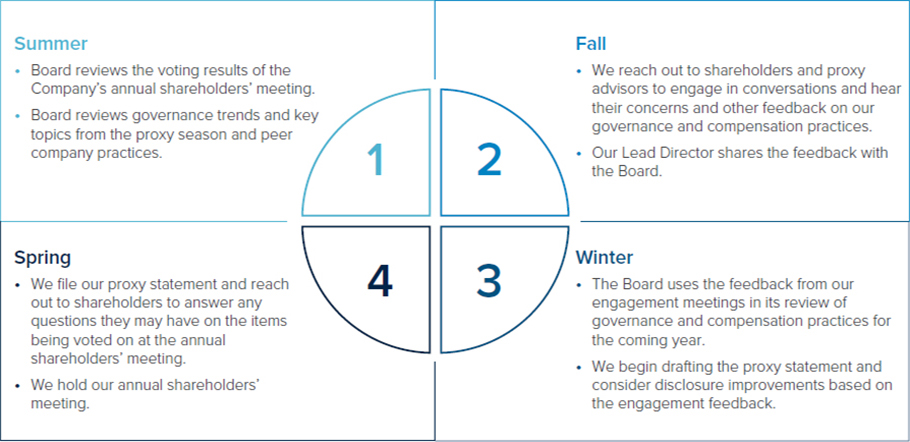
Please continue to share your thoughts or concerns at any time. The Board has established a process to facilitate communication by shareholders with the Board. Please seeBoard, described below.
Communications with the Boardon Page 14.
 | 
|
Corporate Governance
The Board has established a procedure for shareholders and other interested parties to send communications to the non-management members of the Board. Shareholders and other interested parties who wish to communicate directly with the non-management directors of the Company should send a letter to the Board of Directors, c/o Secretary, Foot Locker, Inc., 330 West 34th Street, New York, New York 10001.
The Secretary will promptly send a copy of the communication to the Lead Director, who may direct the Secretary to send a copy of the communication to the other non-management directors and may determine whether a meeting of the non-management directors should be called to review the communication.
A copy of the Procedures for Communications with the Board of Directors is available on the corporate governance section of the Company’s corporate website atwww.footlocker.com/corpgovfootlocker.com/corp. You may obtain a printed copy of the procedures by writing to the Secretary at the Company’s headquarters.
| 2019 Proxy Statement |  19 |
Corporate Governance
Majority Voting in the Election of Outside AdvisorsDirectors
The Board and all of its committees have authority to retain outside advisors and consultants that they consider necessary or appropriate in carrying out their respective responsibilities. The independent accountants are retained
Directors must be elected by and report directly to, the Audit Committee. In addition, the Audit Committee is responsible for the selection, assessment, and terminationa majority of the internal auditors tovotes cast in elections for which the Company has outsourcednumber of nominees for election does not exceed the number of directors to be elected. A plurality vote standard applies to contested elections where the number of nominees exceeds the number of directors to be elected. Our Corporate Governance Guidelines provide that any incumbent director who does not receive a portionmajority of its internal audit function, whichthe votes cast in an uncontested election is ultimately accountablerequired to the Audit Committee. Similarly, the consultant retainedtender his or her resignation for consideration by the Compensation Committee to assist in the evaluation of senior executive compensation reports directly to that committee.
The Company has adopted a Code of Business Conduct for directors, officers,Nominating and other employees, including its Chief Executive Officer, Chief Financial Officer, and Chief Accounting Officer. The Company periodically reviews the Code of Business Conduct and revises it, as appropriate. A copy of the Code of Business Conduct is available on the corporate governance section of the Company’s corporate website atwww.footlocker.com/corpgov. You may obtain a printed copy of the Code of Business Conduct by writing to the Secretary at the Company’s headquarters.
Any waivers of the Code of Business Conduct for directors and executive officers must be approved by the AuditGovernance Committee. The Company promptly discloses amendments to the Code of Business Conduct and any waivers of the Code of Business Conduct for directors and executive officers on the corporate governance section of the Company’s corporate website atwww.footlocker.com/corpgov.
We individually inquire of each of our directors and executive officers about any transactions in which the Company and any of these related persons or their immediate family members are participants. We also make inquiries within the Company’s records for information on any of these kinds of transactions. Once we gather the information, we then review all relationships and transactions of which we are aware in which the Company and any of our directors, executive officers, their immediate family members or five-percent shareholders are participants to determine, based on the facts and circumstances, whether the related persons have a direct or indirect material interest. The General Counsel’s office coordinates the related person transaction review process. The Nominating and Governance Committee reviews any reported transactions involving directors and their immediate family memberswill make a recommendation to the Board whether to accept or reject the resignation, or whether other action should be taken. The director who tenders his or her resignation will not participate in makingthe Committee’s or the Board’s decision. In determining its recommendation to the Board, on the independenceNominating and Governance Committee will consider all factors that it deems relevant. Following such determination, the Company will promptly disclose publicly the Board’s decision, including, if applicable, the reasons for rejecting the tendered resignation.
Proxy Access
Under our proxy access by-law, a shareholder, or a group of up to 20 shareholders, owning at least 3% of the directors. The Company’s written policiesoutstanding Common Stock continuously for at least three years as of the date of the notice of nomination, may nominate and procedures for related person transactions are included within bothinclude in the Corporate Governance GuidelinesCompany’s proxy materials director nominees constituting up to two individuals or 20% of the Board, whichever is greater (subject to certain limitations set forth in the By-Laws), provided that the shareholder(s) and nominee(s) satisfy the Code of Business Conduct. There were no related person transactionsrequirements specified in 2017.

|  |
Corporate Governancethe By-Laws.
Environmental, Social, and Governance Responsibility and ReputationHighlights
The CompanyFoot Locker recognizes thatthe importance of environmental, social, and governance (ESG) issues are of increasing importance to many investors. Managingshareholders and reportingformed a global cross-functional team, including Legal, Human Resources, Supply Chain, Sourcing, and Real Estate/Construction, among other functions, to monitor our ESG business practices helps the Company compete in a business environment characterized by finite natural resources, changing legislation,efforts. The Board oversees our ESG program and heightened public expectations.receives regular updates from management.
As a company, our commitment to community is stronger than ever. Giving back to those in need and enriching people’s lives is a deep-rooted philosophy ingrained in our corporate culture that extends to our associates around the world. Corporate social responsibility is a company-wide commitment informed by, and integrated into, our business strategy. In a year marked by devastation and tragedy, our associates vitalized our core value of community by uniting to effect positive change during an incredible time of need. In the aftermath of the storms and natural disasters that touched so many of our customers and associates, our teams rallied together to offer their support and provide hope in the face of despair. In addition to a monetary contribution from the Foot Locker Foundation, Inc. to the American Red Cross and our long-standing partner, the Two Ten Footwear Foundation, we donated footwear and apparel to families in need in the impacted areas. We also encouraged consumers to donate to the American Red Cross through a national fundraising campaign. In addition, we spearheaded an emergency response effort, providing early shipments of much-needed supplies, including water, food, and toiletries. We launched a philanthropic platform as part of our sixth annual Week of Greatness campaignLocker’s ESG priorities are centered on support for victims of Hurricane Maria. The herculean efforts of our associates during this difficult time is a reflection of the Company’s commitment to support the communities in which we serve—a key philosophy at Foot Locker.
The Company created the Foot Locker Foundation, Inc. in 2001 to channel our support to those in need through educational initiatives. A hallmark of such initiatives is the Foot Locker Scholar Athletes Program, which awards $20,000 college scholarships to 20 student athletes each year. Since its launch in 2011, the program has invested more than $2.5 million in the educationOpportunity;Community;Worker Dignity; and future of some of America’s most promising student athletes. Beyond this program, we have also raised millions of dollars in support of higher education through our annual “On Our Feet” fundraising gala, benefitting hundreds of students through a joint scholarship program with our partner, the United Negro College Fund, Inc. In 2014, Kids Foot Locker collaborated with the Boys & Girls Clubs of America to create the Kids Foot Locker Fitness Challenge, which promotes physical fitness among today’s youth. The Company dedicates significant resources to important social causes that connect with our customers, associates, suppliers, and shareholders around the world, such as the Fred Jordan Missions, the American Cancer Society’s Making Strides Against Breast Cancer Walk, the Pluryn Foundation (The Netherlands), the Starlight Children’s Foundation (Australia), and the Special Olympics (Canada)Sustainability.
The Company was recognized in 2017 with awards for Best Workplaces for Diversity, Best Workplaces in New York and Best Workplaces in Retail, each conferred by the Great Place to Work Institute.
Our Board regularly monitors and supports ESG efforts, including corporate philanthropy, volunteerism, diversity and inclusion, responsible sourcing practices, and stakeholder engagement.
 |  | 
|
We aim to create opportunities for all of Directorsour employees.
The Board has responsibility for establishing broad corporate policies, reviewing significant developments affecting the Company, overseeing the business strategy,
The Board held seven meetings during 2017. All of our directors attended at least 75% of the aggregate of the meetings of the Board are ethnically diverse
| * | U.S. workforce represents 74% of global workforce. |
A director is not considered independent under NYSE rules if he or she has a material relationship with the Company that would impair his or her independence. In addition to the independence criteria established by the NYSE, the Board has adopted categorical standards to assist it in making its independence determinations regarding individual directors. These categorical standards are contained in the Corporate Governance Guidelines, which are posted on the Company’s corporate website atwww.footlocker.com/corpgov.
The Board has determined that the following categories of relationships are immaterial for purposes of determining whether a director is independent under the NYSE listing standards:

| Foot Locker, Inc. |
Corporate Governance
| Fostering Diversity, Inclusion, and Equality | |||
Our goal is to attract, develop, and | |||
| Advancing Careers and Developing Talent |
The Board, upon the recommendation of the Nominating and Governance Committee, has determined that the following directors are independent under the NYSE rules because they have no material relationship to the Company that would impair their independence:
| At Foot Locker, we are all about developing and supporting our people. E-learning, training, and scholarships are a few ways in which we enrich employees professionally. “You Develop,” our e-learning program, features an objectives worksheet to help employees have constructive career conversations with their managers. In 2018, we launched a “Leading in a Matrix Organization” training workshop across our global offices to skill-build in the areas of collaboration and trust to enable employees to work more effectively as a team. Internal and external speakers share lessons learned during “Shoe on This” trainings (sessions are recorded and posted on our employee portal) and our online learning platform, Lynda.com, offers video courses on software and professional skills. Our Foot Locker Associate Scholarship Program awards nine $5,000 scholarships, and one $10,000 scholarship (known as the Ken C. Hicks Associate Scholarship), annually to employees. | |||||

|  |
 21 |
Board of Directors
Corporate Governance
Nicholas DiPaolo served as a director of the Company during 2017 until his retirement from the Board in May 2017. The Board determined that Mr. DiPaolo was independent under the NYSE rules through the end of his term as a director because he had no material relationship to the Company that would impair his independence.
| Benefits | ||
| We believe we offer competitive compensation and benefits, including health and wellness benefits (i.e., medical, dental and vision coverage), financial benefits (i.e., pension, 401(k) Plan with Company matching contribution, Employee Stock Purchase Plan (ESPP) at a 15% discount, and commuter benefits), and work-life balance and lifestyle benefits (paid time off (PTO) and Employee Discount Program). | ||
| To be the best, employees need to feel their best. As part of our comprehensive benefits offering, we provide eligible employees with personalized wellness coaching. The one-on-one program integrates phone and mail-based communications with an online interactive health coach and is designed to target specific goals around nutrition, exercise, and heart health. Select facilities feature an on-site gym for convenient workouts and our employee discount platform, “YouDecide,” offers discounted rates for local fitness clubs. While health is a year-round priority, some corporate offices organize a Wellness Month with free workout classes, a health fair, and fresh fruit delivery. | ||
| We are our customers—our employees are true sneakerheads. One of the great aspects of our culture is our ability to celebrate and fuel the sneaker passion of not just our customers, but also our employees. To celebrate that passion, we offer employee product discounts and access to exclusive offerings from a range of vendors. With the ever-evolving retail landscape, Foot Locker is committed to fostering elevated in-store experiences featuring high-profile guests through vendor partnerships that make us stand out from the crowd. Our employees gain exposure to unique opportunities with athletes, celebrities, and other tastemakers who impact the youth culture that inspires and fuels the Company, as well as access to events like the New York City Marathon (employees can gain coveted entry in the race), NBA All Star Weekend, NBA Drafts, and concerts. | ||
| Ensuring Worker Safety | ||
| We are dedicated to fundamental worker safety. We strive to prevent and promptly address any employee work-related injuries. Over time, we have experienced a decrease in the number of recorded accidents and lost time from employees out of work due to work-related injuries. We have a centralized online reporting system that tracks all incidents and injuries. We analyze the information at least quarterly to assess risks and develop preventive measures. Our Risk Management team analyzes recurring injuries and issues to determine trends and if current policies or practices need to be amended or if more training is required to address risks. Our field auditors review safety measures in their audit process. | ||
| Ethics and Compliance | ||
| Culture is the foundation of everything we do at Foot Locker. We define culture as our values in action. Our culture is one of high performance, and it is how we live out our values.How we do business is just as important aswhat we do. The COBC serves as our ethical compass for the commitment we make to our stakeholders, customers, and one another. Our Global Legal Department manages our COBC program by providing training and online education, and partners with the Internal Controls Department to audit employee assessments. Employees are required to certify COBC compliance annually. When issues arise, our employees are encouraged to speak up and use our open-door process for discussing any concerns. We also provide a confidential COBC hotline. The General Counsel reports to the Audit Committee on the COBC program. | ||
 | Community | |
| We aim to help strengthen and support local communities where we do business. | ||
| ● Raised and donated over $9 million for scholarships since 2004, plus footwear and apparel donations to several organizations | ||
| ● U.S. non-store employees permitted paid time-off for volunteering in their communities | ||
 22 | Foot Locker, Inc. |
Corporate Governance
Adopt One Village Inc, a not-for-profit organization that provides aid to small villages in Ghana At Foot Locker, we do well by doing good. Giving back to those in need and enriching people’s lives is a deep-rooted philosophy imbued in our corporate culture that extends to our employees around the world. That’s why we permit all U.S. non-store employees one paid day off each year to give back to their communities. In 2018, our employees exemplified our core value of community by uniting to effect positive change during times of need. In addition to monetary contributions from the Foot Locker Foundation and our long-standing partner, the Two Ten Footwear Foundation, we donated footwear and apparel to families in need. The Foot Locker Foundation channels our support to those in need through educational initiatives, namely the Foot Locker Scholar Athletes Program, which awards 19 $20,000 scholarships, and one $25,000 scholarship (known as the Ken C. Hicks Scholar Athletes Scholarship), annually to student athletes since 2011. The program has invested nearly $3 million in the education and future of some of America’s most promising student athletes since 2011. We have also raised millions of dollars in support of higher education through our annual “On Our Feet” fundraising gala, benefitting hundreds of students through a joint scholarship program with our partner, the United Negro College Fund, Inc. We have raised and donated over $9 million for scholarships since 2004. In addition, Kids Foot Locker collaborates with the Boys & Girls Clubs of America (BGCA) on the “In My Shoes Challenge” by inviting children from BGCA to share their interests and what it means to them—such as sports, music, art, writing, or photography—by posting a photo and caption through social media. Foot Locker also dedicates significant resources to many other important social causes around the world, such as the Fred Jordan Missions, the Two Ten Foundation, the American Red Cross, the American Cancer Society’s Making Strides Against Breast Cancer Walk, Adopt One Village Inc. (Ghana), the Pluryn Foundation (The Netherlands), the Starlight Children’s Foundation (Australia), and the Special Olympics (Canada). | ||
 | Worker Dignity | |
| We respect all workers involved in our supply chain. | ||
| ● Global Sourcing Guidelines (GSG) are distributed annually to our suppliers | ||
| ● Foot Locker has consolidated its private label supplier base to work more closely with fewer suppliers with deeper partnerships | ||
| ● Private label products sourced by Foot Locker are produced in China (59%), Pakistan (27%), Vietnam (10%), and Other (Thailand, United States, Portugal, Turkey, and Honduras) (4%) | ||
| Foot Locker is concerned with the safety and fair treatment of all workers involved in our supply chain, wherever the workers are located. We work hard to choose reputable business partners who are committed to ethical standards and business practices. At a minimum, we expect our suppliers to comply, and to ensure that their subcontractors comply, with all legal requirements applicable to their business. Foot Locker will only do business with suppliers whose workers are, in all cases, present voluntarily, compensated fairly and allowed the right of free association and who are neither put at risk of physical harm, discriminated against, nor exploited in any way. To this end, Foot Locker has developed GSG, which are distributed annually and require all branded and private-label vendors and suppliers globally to respect certain standards, notwithstanding more relaxed standards, if any, imposed by applicable local law. We have also developed several other policies to address specific ESG concerns, including the Anti-Corruption Policy and Conflict Minerals Policy. The GSG are incorporated into our Vendor Standards Manual. Regular factory audits are performed by a third party or our in-house auditors. Foot Locker also reserves the right to make periodic, unannounced inspections to verify compliance with the GSG. Suppliers agree to maintain and provide, upon request, all documentation necessary to demonstrate compliance. In recent years, we have taken steps to consolidate our supplier base so that we are working more closely with fewer suppliers, and deepen our partnerships with suppliers to forge a more collaborative approach grounded in continuous engagement and improvement. | ||
In making its independence determination, the Board reviewed recommendations of the Nominating and
| 2019 Proxy Statement |  23 |
Corporate Governance Committee and considered Dona D. Young’s and Ulice Payne, Jr.’s relationships as directors of companies with which we do business. The Board has determined that these relationships meet the categorical standard for Relationships with Other Business Entities and are immaterial with respect to determining independence.
The Board also considered, in making its independence determination, Alan D. Feldman’s relationship as a member of the Foundation Board of the University of Illinois, and Matthew M. McKenna’s relationship as an adjunct professor of Fordham University School of Law, because the Foot Locker Foundation awarded a $5,000 scholarship to a student at each of the University of Illinois and Fordham University in 2017. The Board has determined that these relationships meet the categorical standard for Relationships with Not-for-Profit Entities and are immaterial with respect to determining independence.
 | Sustainability | |
| We aim to enhance the sustainability of our operations and value chains. | ||
| ● Reduced energy and eliminated waste | ||
| Our dedication to reducing the environmental impact of our stores, distribution centers, and offices means implementing practices that are more efficient and reducing our waste production. These efforts both reduce our environmental impact and are cost-effective. | ||
| Energy | ||
| Foot Locker is in the process of a multi-year rollout to replace all of its fluorescent fixtures with LED lights—which consume 80% less energy than conventional lights—in its stores, warehouses, and distribution centers. Not only are these changes good for the environment, but they could reduce our annual energy costs over time and they last five to 10 times longer. We have also begun installing “lightstat” thermostats in many of our stores. These “smart” thermostats utilize a photocell to determine whether a space is occupied and resets the heating or cooling accordingly. We are also exploring other options that achieve significant energy reductions while balancing business needs. Our corporate headquarters in New York has partnered with our landlord to set corporate goals to reduce our energy consumption in our headquarters by 35%, aligning with the NYC Mayor’s commitment of reducing 80% of carbon emissions by 2050. | ||
| Distribution | ||
| Foot Locker has implemented measures to reduce its greenhouse gas emissions. We have committed to increasing the amount of freight we ship within each carrier and only shipping trucks or containers once full. We have committed to using cleaner modes of transportation and encouraging the use of fuel-saving strategies and technologies. We are also enhancing our data collection capabilities to better measure results. We are working with our vendor partners and adding mini-distribution centers into our supply chain network to accept and distribute product. This decreases shipping runs and accelerates speed of product to the customer. Our trucks frequently run overnight to reduce idling time and pollution. We also make efforts to ship intermodal when available. | ||
| Waste | ||
| Our biggest waste stream is from packaging, namely boxes used to transport and protect our merchandise as it moves from our distribution centers to stores. We curtail this waste, however, by reusing boxes within our supply chain system and for products returned to the vendors. We do not utilize hangers or tote bags for shipping. We primarily utilize corrugated and recycled boxes and sell back several thousand tons of corrugated boxes for recycling each year. We also continue to search for additional solutions, including through partnerships with our brands, suppliers, and the greater footwear and apparel industry, to reduce packaging weight and change packaging materials to decrease overall waste volume and allow for greater recycling. For example, the Retail Industry Leaders Association (RILA), of which we are a member, has convened retailers to explore ways to collect and recycle these major waste streams. | ||
The Board has determined that all members of the Audit Committee, the Compensation Committee, the Finance Committee, and the Nominating and Governance Committee are independent as defined under the NYSE listing standards and the director independence standards adopted by the Board.
 24 | Foot Locker, Inc. |

The Board has delegated certain duties to committees, which assist the Board in carrying out its responsibilities. There are five standing committees of the Board. Each independent director serves on at least two committees. The key oversight responsibilities of the committees, the current committee memberships, and the number of meetings held during 20172018 are described below.
The Board has adopted charters for each of the Audit Committee, the Compensation Committee, the Finance Committee, and the Nominating and Governance Committee. Copies of the charters for these committees are available on the corporate governance section of the Company’s corporate website atfootlocker.com/corp. You may also obtain printed copies of these charters by writing to the Secretary at the Company’s headquarters.
As a general principle, the Board believes that the periodic rotation of committee assignments on a staggered basis is desirable and provides an opportunity to foster diverse perspective and develop breadth of knowledge within the Board. In 2018, Mr. Feldman rotated off as Chair of the Compensation Committee, remaining as a member of the Committee, and Ms. Underhill took on the role of Committee Chair.
| Audit | ||||
| A | ||||
 | Key Oversight Responsibilities | |||
 | appoints the independent auditors | |||
●approves the independent auditors’ compensation | ||||
●assists the Board in fulfilling its oversight responsibilities in the following areas: | ||||
○accounting policies and practices | ||||
○the integrity of the Company’s financial statements | ||||
○compliance with legal and regulatory requirements | ||||
○the Company’s risk assessment and risk management policies | ||||
○ cybersecurity ○the qualifications, independence, and performance of the independent auditors | ||||
○the qualifications, performance, and compensation of the internal auditors | ||||
○reviews and monitors compliance with the Company’s Code of Business Conduct | ||||
● establishes procedures for the receipt, retention, and treatment of complaints regarding accounting, internal accounting controls, and auditing matters | ||||
This committee consists of | ||||
Chair Guillermo G. Marmol | ||||
Other Members McKenna, Payne, Young 9meetings in 2018 | ||||
 |  
|
Board of Directors
| Compensation | |||
| C | |||
 | Key Oversight Responsibilities | ||
 | determines the compensation of the Chief Executive Officer | ||
●reviews and approves all compensation for the Company’s executive management group, which consists of the executive officers and corporate officers | |||
●responsible for decisions regarding equity compensation for other employees | |||
●assesses risk in relation to the Company’s compensation policies and practices | |||
●administers the Company’s various compensation plans, including the incentive plans, the equity-based compensation plans, and the | |||
| plans) ●reviews and makes recommendations to the Board concerning executive development and succession | |||
● reviews non-employee directors’ compensation and makes recommendations to the Board concerning the form and amount of non-employee directors’ compensation | |||
This committee consists of five independent directors, as independence is defined under the NYSE rules applicable to compensation committee members. | |||
| |||
Chair Kimberly Underhill | |||
Other Members Clark, Feldman, Oakland, Turpin 6meetings in 2018 | |||
| Finance | F | ||
 | Key Oversight Responsibilities ●reviews the Company’s financial plans and objectives ●reviews and makes recommendations to the Board regarding the Company’s annual operating budget and two-year plans ● reviews the Company’s allocation of capital, annual capital budget, and policies related to capital and other expenditures ● reviews and makes recommendations to the Board regarding the Company’s uses of cash, including capital expenditures, stock and bond repurchases, and dividend payments ● reviews and makes recommendations to the Board regarding the Company’s cash requirements and sources of cash, including debt or equity issuances, revolving credit facilities, or other debt instruments or facilities ● reviews the Company’s insurance and self-insurance reserves ● reviews the Company’s derivatives policy and its use of derivatives ● reviews and makes recommendations to the Board regarding proposed mergers, combinations, acquisitions, offers to purchase the Company’s shares or significant assets, divestitures, and strategic investments ● reviews the Company’s Corporate Development Approval process ● reviews reports from the Retirement Plan Committee regarding the asset allocation and investment performance of the Company’s North America pension funds | ||
Chair Matthew M. McKenna | |||
Other Members Clark, Feldman, Marmol, Underhill 9meetings in 2018 | |||
 26 | Foot Locker, Inc. |
Board of Directors
| N | |||
 | Key Oversight Responsibilities | ||
 | |||

|  |
Board of Directors
 | oversees corporate governance matters affecting the Company, including developing and recommending criteria and policies relating to director service and tenure | ||
● establishes criteria for Board candidates | |||
● retains | |||
●selects new director nominees to recommend to the Board | |||
●considers the re-nomination of existing directors after | |||
● reviews membership on the Board committees and, after consultation with the Chief Executive Officer and the Lead Director, makes recommendations to the Board annually regarding committee members and committee chair assignments | |||
●oversees the annual self-assessment process for the Board and committees | |||
● reviews trends and governance with | |||
Shareholders who wish to recommend candidates for Board membership may contact the Nominating and Governance Committee in the manner described on | |||
Chair Steven Oakland | |||
Other Members Payne, Turpin, Young 4meetings in 2018 | |||
| Executive | E | ||
 | Key Oversight Responsibilities | ||
 | ● shares all of the powers of the Board during intervals between Board meetings, except for certain matters reserved to the Board | ||
Chair Richard A. Johnson | |||
Other Members | |||
Marmol, McKenna, | |||
Oakland, Underhill, Young | |||
No meetings in | 2018 | ||
 |  
|
Board of Directors
The Nominating and Governance Committee and Compensation Committee jointly oversee our non-employee director compensation program, and Management Resourcesconduct annual reviews and make recommendations for adjustments, as appropriate, to the Board. The Compensation Committee Interlocksreviews non-employee directors’ compensation and Insider Participationmakes recommendations to the Board concerning the form and amount of non-employee directors’ compensation. The Nominating and Governance Committee reviews trends and governance with regard to non-employee directors’ compensation.
Maxine Clark, Alan D. Feldman, Steven Oakland, Cheryl Nido Turpin, Kimberly Underhill, Dona D. Young,
Our non-employee directors are paid an annual retainer fee and Nicholas DiPaolo (who retiredmeeting fees for attendance at each Board and committee meeting. The Lead Director and the committee chairs are each paid additional retainer fees for service in 2017) servedthese capacities. Our non-employee directors’ compensation program consists of a balance of cash and equity, with an emphasis on equity over cash.
In connection with the review conducted in fiscal year 2018, the independent outside consultant on director compensation retained by the Compensation Committee during 2017. Noneassessed the compensation paid to our non-employee directors against non-employee director compensation trends and data from our company peer group, including overall trends and governance principles, market competitiveness of our program, and the mix of cash and equity provided under our program. After consultation with the independent outside consultant, the Nominating and Governance Committee and Compensation Committee found the non-employee director compensation program to be appropriate, and no changes to the compensation program were recommended or implemented in 2018, as the compensation approximates the peer group median and the pay mix is aligned with peer and broad market practice.
In February 2019, on the recommendation of the committee members was an officer or employeeNominating and Governance Committee, the Board placed a cap of the Company or any$600,000 on non-employee directors’ compensation, inclusive of its subsidiaries,cash and there were no interlocks with other companies within the meaning of the SEC’s proxy rules.equity, for each non-employee director for each fiscal year.
Directors’Key Principles of Director Compensation and BenefitsProgram
Non-employee
| ● | Peer Groups: When establishing reference points for market comparisons of our outside directors’ compensation program, we consider the retail peer group used for our executive compensation purposes and general industry data for similarly-sized companies. SeeBenchmarking Approachon page 45 for more information on our peer group. |
| ● | Pay Evaluation Perspective: When assessing the competitive position of our outside directors’ compensation program, the primary focus is on total targeted compensation opportunity. |
| ● | Pay Position: The targeted pay position for our outside directors’ compensation program is the median of the retail and general industry market reference points. |
| ● | Pay Mix: Our outside directors’ compensation program consists of a balance of cash and equity, with an emphasis on equity over cash. SeeComponents of Director Compensation Programon page 29 for further information. |
| ● | Differentiation: The outside directors’ compensation provides additional compensation for leadership positions on the Board, including non-executive chair, lead director, and committee chair roles. SeeComponents of Director Compensation Programon page 29 for further information. |
| ● | Stock Ownership: Significant stock ownership guidelines established for outside directors encourage better alignment with shareholders’ interests, with compliance measured at least annually, as described further inStock Ownership Guidelineson page 16. |
| ● | Deferral Opportunities: Outside directors are provided with the opportunity to defer compensation by making additional investments in our Common Stock on an elective basis. SeeDeferral Electionon page 29 for further information. |
| ● | Total Compensation Limits: Meaningful limits on outside directors’ compensation have been established to ensure consistency with sound governance practices. |
| ● | Regular Review: The Nominating and Governance Committee conducts regular reviews of governance practices and trends in directors’ compensation to ensure consistency of our program with sound governance practices and makes recommendations, as appropriate, to the Board. The Compensation Committee conducts regular reviews of our outside directors’ compensation program and makes recommendations to the Board regarding the amount and form of directors’ compensation each year. |
 28 | Foot Locker, Inc. |
Board of Directors
Components of Director Compensation Program
Our non-employee directors are paid an annual retainer fee and meeting fees for attendance at each Board and committee meeting. The Lead Director and the committee chairs are each paid additional retainer fees for service in these capacities. We do not pay additional compensation to any director who is also a Company employee for service on the Board or any committee. The independent compensation consultant retained by the Compensation Committee conducts a review and analysisNone of the directors’ compensation program, considering overall trends and governance principles, market competitiveness of the program, and the mix of cash and equity provided under the program and makes recommendationscurrent independent directors is entitled to the Compensation Committee and Nominating and Governance Committee, jointly, with regard to the program structure. No changes to the compensation program were recommended or implemented in 2017, as the compensation approximates the peer group median and the pay mix is aligned with peer and broad market practice. receive any retirement benefits.
Below is a summary of the fees paid to the non-employee directors in 2017:2018:
| Fee | Amount | |||
| Annual Retainer | $140,000 payable 50% in cash and 50% in Common Stock. Directors may elect toreceive up to 100% of their annual retainer, including their committee chair retainer, | |||
| Committee Chair Retainers | $25,000: | Audit Committee Chair | ||
| $25,000: | Compensation Committee Chair | |||
| $15,000: | Finance Committee Chair | |||
| $15,000: | Nominating and Governance Committee Chair | |||
| None: | Executive Committee Chair | |||
| The committee chair retainers are paid in the same form as the annual retainer. | ||||
| Lead Director Retainer | $50,000 payable in cash. | |||
| Meeting Fees | $2,000 per Board and committee meeting attended. | |||
| RSUs | RSUs valued at | |||

|  |
Board of Directors
Deferral Election
Non-employee directors may elect to receive all or a portion of the cash component of their annual retainer fee, including committee chair retainers, in the form of DSUs or to have these amounts placed in an interest account. Directors may also elect to receive all or part of the stock component of their annual retainer fee in the form of DSUs. A DSU is an accounting equivalent of one share of Common Stock. The interest account is a hypothetical investment account bearing interest at the rate of 120% of the applicable federal long-term rate, compounded annually, and set as of the first day of each plan year. A stock unitNone of the current directors have elected to place any amount of their annual retainer fee in an interest account.
Directors’ Retirement Plan
The Directors’ Retirement Plan was frozen as of December 31, 1995. No current directors are eligible to participate in this plan. Currently, two former directors participate in the plan. The retirement benefit under this plan is an accounting equivalent$24,000 per year, payable quarterly for the lesser of one share of Common Stock.10 years after the director leaves the Board or until the director’s death.
Miscellaneous
We reimburse non-employee directors for reasonable expenses incurred in attending Board and committee meetings, other meetings with management, and continuing education programs, including their transportation, hotel accommodations, and meals. Directors and their immediate families are eligible to receive the same discount on purchases of merchandise from our stores, catalogs, and Internet siteswebsites that is available to employees.
| 2019 Proxy Statement |  29 |
Board of Directors
Fiscal 20172018 Director Compensation
The amounts paid to each non-employee director for fiscal 2017,2018, including amounts deferred under the Company’s Stock Incentive Plan, and the RSUs granted to each director are reported in the tables below:
Directors’Director Compensation
| (a) | (b) | (c) | (d) | |||||||||
| Name | Fees Earned or Paid in Cash ($) | Stock Awards ($)(1)(2) | Total ($) | |||||||||
| M. Clark | 98,189 | 139,988 | 238,177 | |||||||||
| N. DiPaolo | 39,375 | 29,124 | 68,499 | |||||||||
| A. Feldman | 105,630 | 185,965 | (3) | 291,595 | ||||||||
| J. Gilbert, Jr. | 104,189 | 139,988 | 244,177 | |||||||||
| G. Marmol | 113,630 | 152,505 | 266,135 | |||||||||
| M. McKenna | 109,074 | 147,478 | 256,552 | |||||||||
| S. Oakland | 65,569 | 188,084 | (3) | 253,653 | ||||||||
| U. Payne, Jr. | 102,190 | 139,988 | 242,178 | |||||||||
| C. Turpin | 96,190 | 193,600 | (3) | 289,790 | ||||||||
| K. Underhill | 92,189 | 139,988 | 232,177 | |||||||||
| D. Young | 141,088 | 224,271 | (3) | 365,359 | ||||||||
 | 
|
Board of Directors
| (a) | (b) | (c) | (d) | (e) | ||||
| Name | Fees Earned or Paid in Cash ($) | Stock Awards ($)(1) | All Other Compensation ($) | Total ($) | ||||
| M. Clark | 112,028 | 139,994 | — | 252,022 | ||||
| A. Feldman | 121,425 | 190,831 | — | 312,256 | ||||
| J. Gilbert, Jr.(2) | 39,384 | 29,115 | 18,000 | (3) | 86,499 | |||
| G. Marmol | 130,550 | 152,472 | — | 283,022 | ||||
| M. McKenna | 125,552 | 147,470 | — | 273,022 | ||||
| S. Oakland | 111,552 | 149,616 | — | 261,168 | ||||
| U. Payne, Jr. | 104,028 | 139,994 | — | 244,022 | ||||
| C. Turpin | 104,028 | 201,456 | — | 305,484 | ||||
| K. Underhill | 115,153 | 139,994 | — | 255,147 | ||||
| D. Young | 120,417 | 263,200 | — | 383,617 |
Notes to Director Compensation Table
| (1) | Column (c) reflects the following |
| (i) | the grant date fair value determined in accordance with FASB ASC 718 for the portion of a director’s annual retainer fees (including committee chair retainer fees) for fiscal year 2018 paid in shares of Common Stock (including any portions deferred in the form of DSUs under the Stock Incentive Plan) ($52.65 per share representing the closing price of a share of Common Stock on June 29, 2018). Such shares of Common Stock are fully vested on grant, regardless of whether deferred into DSUs. |
Retainer fees paid in stock or deferred by the director
| (ii) | the grant date fair value determined in accordance with FASB ASC 718 for the portion of a director’s quarterly retainer fees (including committee chair retainer fees) for fiscal year 2018 payable in cash but deferred in the form of DSUs under the Stock Incentive Plan ($47.29 per share for DSUs granted on January 1, 2018 (pro rated for two months of 2018 fiscal year), $43.83 per share for DSUs granted on April 1 2018, $52.04 per share for DSUs granted on July 1, 2018, and $50.20 per share for DSUs granted on October 1, 2018 representing the closing price of a share of stock on the quarterly grant date). Such shares of Common Stock are fully vested on grant. |
| (iii) | the grant date fair value determined in accordance with FASB ASC 718 for RSUs granted in fiscal year 2018 ($45.03 per share representing the closing price of a share of Common Stock on the grant date). The RSUs will vest in May 2019. The amounts shown exclude the impact of estimated forfeitures related to service-based vesting conditions. |
| (iv) | the grant date fair value, determined in accordance with FASB ASC 718, for dividend equivalents paid on DSUs and credited in the form of additional DSUs, made to Messrs. Feldman and Oakland and Mmes. Turpin and Young ($41.67 per share for DSUs granted on May 4, 2018, $47.16 per share for DSUs granted on August 3, 2018, $48.80 per share for DSUs granted on November 2, 2018, and $55.60 per share for DSUs granted on February 1, 2019, representing the closing price of a share of stock on the quarterly payment date). Such DSUs are fully vested on grant. |
The fiscal 2017following table sets forth the grant date fair value for the portion of the annual retainer fees, including committee chair retainer fees, paidabove stock awards granted to our directors in shares of Common Stock or deferred by the director, is shown in the following table:fiscal year 2018:
| Name | Shares (#) | DSUs (#) | Grant Date Fair Value ($) | Stock Fees (including DSUs) ($) | RSUs ($) | Dividend Equivalents ($) | Total ($) | |||||||||||||
| M. Clark | 1,420 | — | 69,978 | 69,972 | 70,022 | — | 139,994 | |||||||||||||
| N. DiPaolo | 591 | — | 29,124 | |||||||||||||||||
| A. Feldman | 1,674 | — | 82,495 | 82,450 | 70,022 | 38,359 | 190,831 | |||||||||||||
| J. Gilbert, Jr. | 1,420 | — | 69,978 | 29,115 | — | — | 29,115 | |||||||||||||
| G. Marmol | 1,674 | — | 82,495 | 82,450 | 70,022 | — | 152,472 | |||||||||||||
| M. McKenna | 1,572 | — | 77,468 | 77,448 | 70,022 | — | 147,470 | |||||||||||||
| S. Oakland | 2,358 | — | 116,202 | 77,448 | 70,022 | 2,146 | 149,616 | |||||||||||||
| U. Payne, Jr. | 1,420 | — | 69,978 | 69,972 | 70,022 | — | 139,994 | |||||||||||||
| C. Turpin | 1,420 | — | 69,978 | 69,972 | 70,022 | 61,462 | 201,456 | |||||||||||||
| K. Underhill | 1,420 | — | 69,978 | 69,972 | 70,022 | — | 139,994 | |||||||||||||
| D. Young | — | 1,642 | 80,655 | 106,000 | 70,022 | 87,178 | 263,200 | |||||||||||||
Stock portion of retainer fee.We made the annual stock payment to each director on July 1, 2017. Under the terms of the Stock Incentive Plan, the stock payment was valued at the closing price of a share of Common Stock on June 30, 2017, which was $49.28. The 2017 grant date fair value is equal to the number of shares received or deferred by the director multiplied by $49.28, calculated in accordance with stock-based compensation accounting rules. One director, who deferred the stock portion of her annual retainer, was credited with DSUs on the annual payment date, valued at $49.28 per unit.
Cash portion of retainer fee.For fiscal 2017, one director deferred part of the cash portion of her annual retainer fee and was credited during the fiscal year with DSUs on the quarterly cash retainer payment dates, valued at the fair market value on the payment dates, as follows: January 1, 2017 ($71.73; pro rated for 2 months of 2017 fiscal year), April 1, 2017 ($74.35), July 1, 2017 ($50.64), October 1, 2017 ($34.75), and January 1, 2018 ($47.89; pro rated for one month of 2017 fiscal year). The 2017 grant date fair value is equal to the number of DSUs received multiplied by the fair market value on the payment dates, calculated in accordance with stock-based compensation accounting rules.
Dividend equivalents
The fiscal 2017 grant date fair values for dividend equivalents credited in the form of additional stock units to four directors during the year on the quarterly dividend payment dates, valued at the fair market value of the Common Stock on the dividend payment dates, are shown in the following table:
| Name | 04/28/17 FMV: $77.34 (#) | 07/28/17 FMV: $46.02 (#) | 10/27/17 FMV: $31.55 (#) | 02/02/18 FMV: $48.38 (#) | ||||||||||||
| A. Feldman | 107 | 181 | 266 | 175 | ||||||||||||
| S. Oakland | 6 | 10 | 15 | 10 | ||||||||||||
| C. Turpin | 172 | 290 | 426 | 280 | ||||||||||||
| D. Young | 231 | 400 | 588 | 388 | ||||||||||||

|  |
Board of Directors
The total number of DSUs credited to directors’ accounts for fiscal 2017, including the dividend equivalents and the units credited representing 2017 retainer fees reported in the above two tables, and the total number of units held at the end of fiscal 2017, are shown in the following table:
| Total DSUs | ||||||||
| Name | Credited for 2017 (#) | Held at 2/3/18 (#) | ||||||
| A. Feldman | 729 | 27,475 | ||||||
| S. Oakland | 41 | 1,537 | ||||||
| C. Turpin | 1,168 | 44,023 | ||||||
| D. Young | 3,249 | 60,916 | ||||||
Restricted Stock Units
The fiscal 2017 grant date fair value for the RSUs granted to the non-employee directors in 2017 is shown in the table below. The number of RSUs granted was calculated by dividing $70,000 by $70.86, which was the closing price of a share of Common Stock on the grant date. The RSUs will vest in May 2018. The amounts shown exclude the impact of estimated forfeitures related to service-based vesting conditions. For additional information on the valuation assumptions, please refer to Note 21 to the Company’s financial statements in our 20172018 Annual Report on Form 10-K. The following table shows the aggregate number
 30 | Foot Locker, Inc. |
Board of RSUs granted in 2017 andDirectors
As of end of fiscal year 2018, the number of RSUs outstanding at the end of the 2017 fiscal year:and DSUs held by our directors was as follows:
| Name | RSUs Granted (#) | Grant Date Fair Value ($) | RSUs Outstanding on 2/3/18 (#) | RSUs Outstanding on 02/02/19 (#) | DSUs Outstanding on 02/02/19 (#) | |||||||||||
| M. Clark | 988 | 70,010 | 988 | 1,555 | — | |||||||||||
| A. Feldman | 988 | 70,010 | 988 | 1,555 | 28,279 | |||||||||||
| J. Gilbert, Jr. | 988 | 70,010 | 988 | |||||||||||||
| G. Marmol | 988 | 70,010 | 988 | 1,555 | — | |||||||||||
| M. McKenna | 988 | 70,010 | 988 | 1,555 | — | |||||||||||
| S. Oakland | 988 | 70,010 | 988 | 1,555 | 1,582 | |||||||||||
| U. Payne, Jr. | 988 | 70,010 | 988 | 1,555 | — | |||||||||||
| C. Turpin | 988 | 70,010 | 988 | 1,555 | 45,310 | |||||||||||
| K. Underhill | 988 | 70,010 | 988 | 1,555 | — | |||||||||||
| D. Young | 988 | 70,010 | 988 | 1,555 | 64,779 | |||||||||||
| (2) |
| (3) |
Directors’ Retirement Plan
The Directors’ Retirement Plan was frozen as of December 31, 1995. Consequently, only Jarobin Gilbert, Jr., who is retiring from the Board in May 2018 following the Annual Meeting of Shareholders, is entitled to receive a benefit under this plan because he completed at least five years of service as a director prior to December 31, 1995. The retirement benefit under this plan is $24,000 per year, payable quarterly for the lesser of 10 years after the director leaves the Board or until his death.
 | 
|
Board of Directors
Directors and Officers Indemnification and Insurance
We have purchased directors and officers liability and corporation reimbursement insurance from a group of insurers comprising ACE American Insurance Co. (Chubb), Zurich American Insurance Co., North American Specialty Insurance Co. (SwissRe), Travelers Casualty and SuretySt. Paul Mercury Insurance Company of America,(Travelers), Freedom Specialty Insurance Co. (Nationwide), Berkley Insurance Co., Argonaut Insurance Co., Beazley Insurance Company, Inc., XL InsuranceCatlin Bermuda Ltd., Illinois National Insurance Co.Union (AIG), and Endurance American Insurance Co. These policies insure the Company and all of the Company’sits wholly-owned subsidiaries. They also insure all of the directors and officers of the Company and the covered subsidiaries. The policies were written for a term of 12 months, from October 12, 20172018 until October 12, 2018.2019. The total annual premium for these policies, including fees and taxes, is $903,220.$914,448. Directors and officers of the Company, as well as all other employees with fiduciary responsibilities under the Employee Retirement Income Security Act of 1974, as amended, are insured under policies issued by a group of insurers comprising Zurich American Insurance Co., Travelers Casualty, and Surety Company of America, and ACE American Insurance Co. (Chubb), which have a total premium, including fees and taxes, of $330,250 for the 12-month period ending October 12, 2018.2019.
The Company has entered into indemnification agreements with its directors and officers, as approved by shareholders at the 1987 Annual Meeting.

|  |
Beneficial Ownership of the Company’s Stock
Directors and Executive Officers
The table below shows the number of shares of Common Stock reported to us as beneficially owned by each of our directors and NEOs as of March 26, 2018. The table also shows beneficial ownership by all directors, NEOs, and executive officers as a group as of that date, including shares of Common Stock that they have a right to acquire within 60 days after March 26, 2018 by the exercise of stock options.
No director or NEO beneficially owned 1% or more of the total number of outstanding shares as of March 26, 2018. Each person has sole voting and investment power for the number of shares shown unless otherwise noted.
| Name | Common Stock Beneficially Owned Excluding Stock Options (#) (a) | Stock Options Exercisable Within 60 Days After 3/26/18 (#) | RSUs and DSUs (#) (b) | Total (#) | ||||||||||||
| Maxine Clark | 10,833 | — | 988 | 11,821 | ||||||||||||
| Alan D. Feldman | 62,644 | — | 28,463 | 91,107 | ||||||||||||
| Jarobin Gilbert, Jr. | 8,884 | — | 988 | 9,872 | ||||||||||||
| Stephen D. Jacobs | 69,459 | 84,970 | — | 154,429 | ||||||||||||
| Richard A. Johnson | 268,929 | 695,889 | — | 964,818 | ||||||||||||
| Lewis P. Kimble | 36,958 | 68,634 | — | 105,592 | ||||||||||||
| Guillermo G. Marmol | 30,148 | — | 988 | 31,136 | ||||||||||||
| Matthew M. McKenna | 35,000 | — | 988 | 35,988 | ||||||||||||
| Steven Oakland | 8,357 | — | 2,525 | 10,882 | ||||||||||||
| Ulice Payne, Jr. | 1,420 | — | 988 | 2,408 | ||||||||||||
| Lauren B. Peters | 137,048 | 246,703 | — | 383,751 | ||||||||||||
| Cheryl Nido Turpin | 45,624 | — | 45,011 | 90,635 | ||||||||||||
| Kimberly Underhill | 1,420 | — | 988 | 2,408 | ||||||||||||
| Pawan Verma | 61,077 | 21,881 | — | 82,958 | ||||||||||||
| Dona D. Young | 41,539 | — | 61,904 | 103,443 | ||||||||||||
| All 20 directors and executive officers as a group, including the NEOs | 1,018,697 | 1,333,028 | 143,831 | 2,495,556 | (c) | |||||||||||
 |  
|
Beneficial Ownership of the Company’s Stock
Persons Owning More Than Five-Percent of the Company’s Common Stock
The table below provides information on shareholders who beneficially own more than 5% of our Common Stock as of December 31, 2017 according to reports filed with the SEC. To the best of our knowledge, there are no other shareholders who beneficially own more than 5% of a class of the Company’s voting securities.
| Name and Address of Beneficial Owner | Amount and Nature of Beneficial Ownership (#) | Percent of Class | ||||||
| The Vanguard Group, Inc. | 12,181,008 | (a) | 10.04 | %(a) | ||||
| 100 Vanguard Boulevard | ||||||||
| Malvern, Pennsylvania 19355 | ||||||||
| BlackRock, Inc. | 7,364,726 | (b) | 6.1 | %(b) | ||||
| 55 East 52nd Street | ||||||||
| New York, New York 10055 | ||||||||
Section 16(a) Beneficial Ownership Reporting Compliance
Section 16(a) of the Exchange Act requires that our directors, executive officers, and persons who own more than 10% of the Company’s Common Stock file reports of ownership and changes in ownership of the Company’s Common Stock with the SEC. Based solely on our review of copies of such forms furnished to the Company and written representations that no other reports were required during the 2017 fiscal year, we believe that during the 2017 fiscal year, the persons subject to Section 16(a) reporting complied with all applicable SEC filing requirements, except as follows: Paulette R. Alviti, Senior Vice President and Chief Human Resources Officer, filed a late Form 4 regarding an intra-plan transfer of approximately 49 shares held through the Company’s 401(k) Plan. This intra-plan transfer was executed on February 27, 2018. Promptly upon being informed of the intra-plan transfer on March 27, 2018, the Company reported it on a Form 4 on Ms. Alviti’s behalf.

|  |
Proposal 2: Advisory Approval of Executive Compensation
The Board is asking our shareholders to approve, on a non-binding, advisory basis, the compensation of our NEOs, as described in this Proxy Statement on Pages 28pages 33 through 72. This advisory “Say-on-Pay” vote is required under Section 14A of the Exchange Act. Consistent with the preference expressed by a majority of our shareholders, we67. We currently hold our Say-on-Pay“Say-on-Pay” vote every year. Shareholders will have an opportunity to cast an advisory vote on the frequency of Say-on-Pay votes at least every six years. The next advisory vote on the frequency of the Say-on-Pay vote is expected to occur at the 2022 Annual Meeting.
As described in detail under the CD&A beginning on Page 28,page 33, our compensation program is designed to attract, motivate and retain talented executives responsible for leading our strategic priorities and, in orderturn, deliver value to maintain and enhance the Company’s performance and its return toour shareholders. In order to accomplish this, we have aOur executive compensation program for our executives, including the NEOs, that ties pay closely to performance. A significant portion of the compensation provided to the NEOs is based upon the Company’s performance or the performance of our share price, and we believe this compensation structure closely aligns the interests of our NEOs with the interests of our shareholders. The more senior an executive’s position, the greater portion of his or her compensation that is tied to performance.
At the 20172018 Annual Meeting, almost 92%95% of the votes cast on the advisory vote to approve the compensation of our NEOs were voted in favor of the proposal. The Compensation Committee believes this affirms our shareholders’ support for the Company’s approach to executive compensation. We believe you should read the CD&A and the compensation tables beginning on Page 28page 33 in determining whether to approve this proposal.
The vote on this resolution is not intended to address any specific element of compensation; rather, the vote relates to the compensation of our NEOs as a whole, as described in this Proxy Statement in accordance with the SEC’s compensation disclosure rules. The vote is advisory, which means that the vote is not binding on the Company, our Board or the Compensation Committee. Our Board and the Compensation Committee value the opinions of all of our shareholders. The Compensation Committee will review and consider the results of this advisory vote.
The Board recommends approval of the following resolution:
“RESOLVED, that the Company’s shareholders approve, on an advisory basis, the compensation of our NEOs, as disclosed in the Company’s Proxy Statement for the 20182019 Annual Meeting pursuant to the SEC’s compensation disclosure rules, including the CD&A, the 20172018 Summary Compensation Table, and the other related tables and disclosures.”

✔The Board recommends a voteFORProposal 2.
  32 | 
|
Compensation Discussion and Analysis
This Compensation Discussion and Analysis, or CD&A, describes our compensation philosophy and objectives and provides context for compensation decisions for our NEOs, and discusses how our 20172018 compensation is linked to performance against the goals that were established for the annual and long-term incentive compensation programs. For 2017,2018, our NEOs were as follows:
 |  |  |  |  | ||||
| Richard A. Johnson | Lauren B. Peters | Stephen D. “Jake” Jacobs | Lewis P. Kimble* | Pawan Verma | ||||
| Chairman, President and Chief Executive Officer | ||||||||
| Executive Vice President and Chief Financial Officer | ||||||||
| Executive Vice President and Chief Executive Officer— North America | Executive Vice President and Chief Executive Officer— | |||||||
| Executive Vice President and Chief Information and Customer Connectivity Officer |
| * | Mr. Kimble served as Executive Vice President and Chief Executive Officer-International during 2018. He has been Executive Vice President and Chief Executive Officer-Asia Pacific since March 11, 2019. |
Table of Contents
| 34 | |||||
| Our Key Compensation Governance Policies | |||||
| 35 | |||||
| 35 | |||||
| Impact of Company Performance on Annual and Long-Term Incentive Pay | |||||
| 36 | Say-on-Pay Shareholder Vote | ||||
| 36 | |||||
| 37 | 2018 Compensation Decisions | ||||
| 38 | |||||
| 38 | Components of | ||||
| 38 | Base Salaries | ||||
| 38 | Annual Bonus Plan | ||||
| 40 | AFG Award | ||||
| 41 | Long-Term Incentive Program | ||||
| 43 | |||||
| Retirement Plan and Excess Cash Balance Plan | |||||
| 43 | 401(k) Plan |
| 43 | ||||
| 44 | International Assignment Compensation | |||
| 44 | Perquisites | |||
| 44 | Executive Employment Agreements | |||
| 45 | ||||
| Procedures for Determining Compensation | ||||
| 45 | Setting Compensation, Establishing Goals, and Evaluating Performance | |||
| 45 | Benchmarking Approach | |||
| 47 | Use of Compensation Consultants | |||
| 47 | Management Involvement in Developing the Compensation Program | |||
| 47 | Additional Information | |||
| 47 | Key Compensation Governance Policies | |||
| 48 | Compensation Plans and Risk | |||
| 49 | Delegation of Authority | |||
| 49 | Items Disregarded for Bonus Calculations | |||
| 49 | Accounting and Tax Considerations of Executive Compensation |

|  |
 33 |
Executive Compensation
Our Compensation Committee, comprised of five independent directors, oversees the executive compensation program. We design our executive compensation program to attract, motivate, and retain talented executives responsible for leading the Company’s short- and long-term strategic priorities and, in turn, deliver value to our shareholders. The centerpiece of our program is our pay-for-performance philosophy that aligns pay outcomes to the achievement of our annual operating plan and long-term strategy, and the creation of shareholder value. This is especially true at senior levels of the Company where a significant portion of compensation is tied to Company performance. As shown in the charts below, 85%92% of the CEO’s target compensation mix and 70%80%, on average, of the other NEOs’ target compensation mix for the compensation program represented performance-based compensation for 2017.2018.
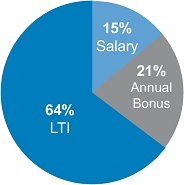 |  | |
CEO’s 2018 Target Compensation Mix
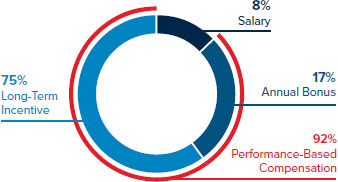
Average of Other NEOs’ 2018 Target Compensation Mix

Our Key Compensation Governance Policies
What We Do
 | Closely align executive pay with performance and Company’s strategy |
 | ✔ | Set rigorous, objective performance goals |
 | ✔ | Maintain a clawback policy |
 | ✔ | Impose and monitor meaningful stock |
 | ✔ | Require a one-year time-based vesting period for earned long-term incentive plan (“LTIP”) payouts following attainment of performance goals |
 | ✔ | Include double-trigger change in control |
 | ✔ | Mitigate undue risk in compensation programs |
 | ✔ | Provide reasonable perquisites |
 | ✔ | Retain independent compensation consultant |
 | ✔ | Hold annual “Say-on-Pay” advisory vote |
 | ✔ | Conduct shareholder outreach |
What We Do Not Do
 | ✖ | No tax gross-ups for perquisites or change incontrolpayments |
 | ✖ | Nohedging of the Company’s stock |
 | ✖ | No repricing of stock options without shareholderapproval |
 | ✖ | Nostock options granted below fair market value |
 | ✖ | No dividends or dividend equivalents on |
 | ✖ | No excessive severance benefits |
 | 
|
Executive Compensation
Organizational Changes
We made several strategic organizational changes in 2017 intended to position the Company for success in a dynamic retail environment. Importantly, we realigned our organizational structure to give all-channel sales and profit responsibility (direct-to-customer and stores) to Mr. Jacobs for North America and Mr. Kimble for International to eliminate channel barriers. In addition, we expanded the Chief Information Officer’s role by promoting Mr. Verma to Chief Information and Customer Connectivity Officer, recognizing the critical role that technology and data play in the customer’s engagement and our omnichannel evolution.
Performance Highlights
We were a highly profitable company in 2017, and despite the challenges and disruptive retail environment we faced during the year, we produced some notable achievements. Highlights include the following:
 34 | Foot Locker, Inc. |
Executive Compensation
We built positive momentum and improved our financial results in 2018. Highlights include the following:
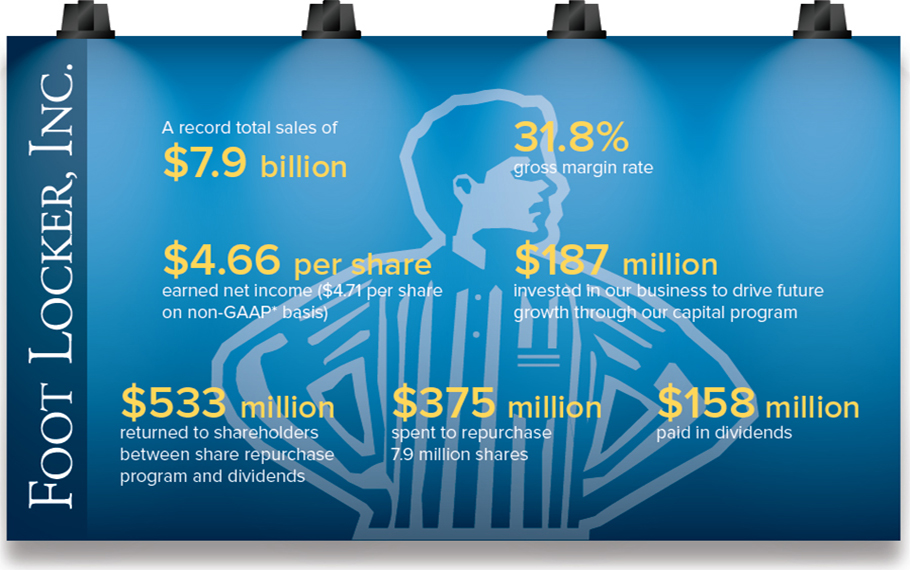
| * | A reconciliation to GAAP is provided beginning on |
Impact of Company Performance on Annual and Long-Term Incentive Pay
Foot Locker strives to be a consistently high-performing company, with a history of setting very challenging performance goals. WhenOnly when we achieve or exceed our goals are incentive payouts are earned. While
Our most-recently completed performance periods illustrate our commitment to pay for performance. Overall, our 2018 fiscal year was very strong, and we were highly profitableprofitable; however, we fell short of our plan in 2017, our performance did not measure up tocertain areas of the rigorous performance goals that were established under the business. As a result, Mr. Johnson, Ms. Peters, and Mr. Verma earned annual incentive payouts of 84.5% of their respective target awards for 2018.
Annual Bonus Plan for 2017 or the Long-Term Incentive Plan (“LTIP”) for the 2016-17 performance period. As a result, the NEOs did not earn any incentive payouts for these performance periods.Corporate Executives
| Performance Metric | ||||||
| Financial Performance Metric | (in millions) Adjusted Pre-Tax (weighted 80%) |
| Profit Payout 87.6% | ||
 | Customer Connected Scorecard Know Our Customers/ Satisfy Our Customers (weighted 20%) | Customer Connected Payout 72.1% | ||||
Total Annual Bonus Payout (Corporate Executives) | 84.5% | |||||
Please see Pages 33
| 2019 Proxy Statement |  35 |
Executive Compensation
As division executives, Mr. Jacobs’s and Mr. Kimble’s annual incentive awards were based on their respective division’s omni-channel profit (weighted 80%) and customer connected scorecard (weighted 20%). Mr. Jacobs earned an annual incentive payout of 157.2% of his target award. Mr. Kimble did not earn a payout for 2018.
LTIP
For the two-year 2017-18 performance period under the LTIP, no payouts were earned by any of the NEOs because our performance over this two-year period did not meet the rigorous goals we established for the period.
| Performance Metrics | Target | Payout | |
 | Average Annual Adjusted Net Income (in millions) |  $727.2 | 0% of Target Award |
 | Two-Year Average ROIC |  15.5% | |
See pages 38 through 3642 for more details on these incentive programs and performance goals.

|  |
Executive Compensation

At our 20172018 Annual Meeting, almost 92%95% of shareholders voting on the advisory vote on executive compensation supported the executive compensation program. The Compensation Committee considered the results of the 20172018 Say-on-Pay vote and our shareholders’ strong support of our executive compensation program in reviewing the executive compensation program for 2018.2019. In light of this support, the Compensation Committee decided to retain the general program design, which ties executive pay closely withbut added new customer connected objectives to the annual incentive plan, reflecting the Company’s customer-centric priorities, and granted a new long-term incentive intended to accelerate growth and better enable the Company performance.to compete in a rapidly changing retail landscape. In the future, the Compensation Committee will continue to assess the executive compensation program against changing business conditions and shareholder feedback. Our Say-on-Pay vote is currently held on an annual basis, consistent with the preference expressed by a majority of our shareholders.
20172018 Compensation Design Changes
During the Compensation Committee’s 2018 compensation planning cycle, the Committee considered the Company’sstrategic initiatives and long-term goals, recognizing the significant disruption that was occurring in the retail industry, and discussed the actions and results that were critical to incentivize through the executive compensation program. As a result, the 2018 incentive compensation design represents a portfolio approach that is intended to motivate the right behaviors and reward achievement of our short- and long-term business results. In addition to providing incentives through the core annual cash incentive plan and LTIP, the Committee determined that an additional long-term incentive award distinctly focused on accelerating the Company’s growth, both organic and inorganic, in this disruptive environment was appropriate and in the best interests of the Company and our shareholders.
Our executive compensation program uses distinct metrics and varying time periods, which the Committee believes provide the appropriate incentives while also managing risk. The changes to the short- and long-term incentives for the NEOs, which are described below, are designed to incentivize the execution of the Company’s customer connected strategy, to accelerate our long-term growth, and to further align our executives’ and shareholders’ interests.
 36 | Foot Locker, Inc. |
Executive Compensation
| Annual Cash Incentive | ● | Incorporated strategic metrics in addition to financial metrics into the core design of the annual incentive plan. Knowing and focusing on the customers of each of our brands increases the opportunity to provide the products and experiences they desire and increases the opportunity to satisfy our customers. Given the Company’s customer-centric culture, the Committee added “customer connected” objectives and enablers composed of additional project milestones that support these objectives to the financial metrics in the annual cash incentive program. The customer connected objectives are weighted at 20%. The remaining 80% of the annual incentive is based on pre-tax income (for corporate executives) or division omni-channel profit (for division executives). | ||
| ● | Modified the maximum for the annual incentive performance range from 120% to 110%, which is consistent with our peers. | |||
| Long-Term Equity Incentives | ● | Rebalanced the annual equity awards for executives by splitting the total value of the award between stock options and time-based RSUs, rather than granting the full value of the award in stock options, in order to increase the retentive aspect of the awards. | ||
| ● | Eliminated the cash portion of the payout for earned awards under the LTIP beginning with the 2018-19 performance period and paying the entire earned award in equity for all NEOs to further align our executives’ and shareholders’ interests. | |||
| ● | Provided an additional long-term incentive opportunity through the Accelerate Future Growth (“AFG”) award specifically focused on accelerating the Company’s growth, expanding our direct-to-customer business, and maintaining the profitability of our “brick and mortar” stores over a three-year period (2018-20). The AFG award is 100% performance-based for the CEO and 75% performance-based for the other NEOs and is payable in RSUs. |
The Compensation Committee made compensation decisions for our NEOs in 2017,2018, including setting and approving incentive compensation performance goals. In making its decisions, the Committee considered (i) the significant disruption occurring in the retail industry, (ii) each executive’s compensation components in light of his or her position and responsibilities, (ii)(iii) internal peer pay comparisons, (iii)(iv) relevant market data for comparable positions and, where applicable, year-over-year changes in market data, and (iv)(v) retention and succession planning.
NEOs’ Compensation Changes in 2017
In its annual review of compensation for 2017, the Compensation Committee’s objective was to maximize the core compensation program to deliver target compensation, enhance the focus on achieving long-term strategic objectives, and further strengthen the retentive elements of the overall program. This resulted in the Committee adjusting the form of LTIP payment for Mr. Johnson and the value of the incentive and stock option components for Mr. Jacobs and Ms. Peters.
| ● | No base salary increases were approved for the NEOs for 2018 given the Committee’s desire to provide accountability for the | |||
Incentive Award | ● | The Committee increased the | ||
| AFG Award | ● | The Committee | ||
Equity Incentives | ● | Beginning with the 2018-19 performance period, earned payouts for all NEOs will be in the form of equity, as the Committee |
Later in the year, the Compensation Committee reviewed Mr. Verma’s compensation in connection with his promotion and made certain changes commensurate with his expanded role.
 |  
|
Executive Compensation
Our Compensation Program Design and Structure
Components of Our Executive Compensation Program
Another goal of the Compensation Committee is to align the compensation program with our business strategy and our shareholders’ interests. In order to achieve these objectives, our executive compensation program includes a mix of annual and long-term compensation, as well as a mix of cash and equity compensation. The key components of our executive compensation program are described in the following chart:
| Compensation Component | Description and Purpose | |||
 | ||||
| Base Salary | Annual fixed compensation supports the objective of attracting and retaining talented executives. | |||
| Provides executives with market-competitive fixed compensation appropriate to their position, experience, and responsibilities. | ||||
| ANNUAL | ||||
| Performance-Based Annual Cash | Incentive | Links annual cash compensation to attainment of short-term performance goals based on the Company’s pre-tax income, division omni-channel profit, and | ||
| LTI Program | Comprises the performance-based LTIP, stock options, and time-based RSUs. These long-term incentives and awards, which are linked to multi-year performance goals and the Company’s stock price, provide an incentive to work towards achievement of long-term strategic objectives. Long-term incentives support executive retention. | |||
| Two-year performance goals based on net income (70%) and ROIC (30%), with an additional one-year vesting period for earned awards. | ||||
| LONG-TERM | ||||
| Stock Options | Provide the opportunity to purchase stock at the exercise price over a ten-year period from the grant date, subject to applicable vesting and exercisability conditions. | |||
| Link realized compensation over long-term appreciation in stock price and represent value to executives only if the stock | ||||
| RSUs | Time-based RSUs align executives’ and shareholders’ interests with value that fluctuates based on stock price performance. | |||
| AFG award incentivizes accelerated growth over a three-year period (2018-20) to build on our strength and grow our business in a disruptive retail environment. This award is 100% performance based for the CEO and 75% performance based for the other NEOs. | ||||
| OTHER | Retirement Benefits | Provide pension and retirement savings benefits, which align with the objective of attracting and retaining talented executives. | ||
| Perquisites | Offer reasonable perquisites similar to our peer companies, which also aid in attracting and retaining talented executives. |

|  |
Executive Compensation
As part of its annual review, the
The Compensation Committee did not approve any base salary increases for the NEOs for 2017,2018, given the continued market competitiveness of their salaries as well as the Committee’s desire to provide accountability for the Company’s below-targetbelow-threshold performance in 2016. However,2017.
In 2018, the Compensation Committee considered the Company’s strategic initiatives relating to customer engagement and creating desired experiences in an environment where customers have many shopping choices. Given this, the Committee approved an increaseincorporated “customer connected” objectives into the annual incentive plan to further incentivize execution of our customer-centric initiatives, in Mr. Verma’s annual base salaryaddition to $550,000 from $465,000, effective October 1, 2017, in connection with his promotion.the financial metrics that have historically been utilized for this performance-based plan. The financial targets are weighted 80%, and the customer connected objectives are weighted 20%.
| Name | 2016 Base Salary | 2017 Base Salary | ||
| R. Johnson | $1,100,000 | $1,100,000 | ||
| L. Peters | $675,000 | $675,000 | ||
| S. Jacobs | $850,000 | $850,000 | ||
| L. Kimble | $650,000 | $650,000 | ||
| P. Verma | $465,000 | $550,000 | * | |
Annual Bonus Plan
The financial targets established by the Compensation Committee establishes targets under the Annual Bonus Plan thatannual incentive plan are based upon the business plan and budget reviewed and approved each year by our Finance Committee and the Board. Pursuant to the Annual Bonus Plan, the Compensation Committee established a corporate performance target for Mr. Johnson, Ms. Peters, and Mr. Verma for 2017 based upon the Company’s achievement of a prescribed level of pre-tax profit, and established performance targets for Mr. Jacobs and Mr. Kimble for 2017 based on division profit. The Annual Bonus Plan for the NEOs makes bonus payments based upon the Company’s or relevant division’s results, without individual performance adjustments. Executives who receive a “not meeting performance” rating in their annual performance review are ineligible to receive an annual bonus payment. All bonus targets and calculations are based on the results of continuing operations through the end of the 2017 fiscal year. The payment of performance-based annual cash bonuses is calculated as a percentage of actual base salary earned by the executive during the year. Beginning in 2017, the maximum payout under this plan was increased from 175% to 200% of target, with a maximum payout in any year for any participant capped at $6 million.
The 2017 annual bonus target awards approved by the Compensation Committee are set out in the table below.
| Name | 2016 Annual Target Award | 2017 Annual Target Award | ||||||
| R. Johnson | 150 | % | 150 | % | ||||
| L. Peters | 75 | % | 75 | % | ||||
| S. Jacobs | 75 | % | 100 | % | ||||
| L. Kimble | 75 | % | 75 | % | ||||
| P. Verma | 50 | % | 75 | %* | ||||
| 50 | %* | |||||||
 | 
|
Executive Compensation
At the beginning of 2017, the Compensation Committee established annual bonus performance targets under the Annual Bonus Plan for the NEOs. Thefinancial targets applicable to Mr. Johnson, Ms. Peters, and Mr. Verma were based on the Company achieving adjusted pre-tax incomeAdjusted Pre-Tax Income of $1,086.4$766.8 million for 2017, a 7.4% increase over 2016 adjusted pre-tax income,2018, in line with the Company’s financial plan and strategic objectives. However, no annual bonuses were earned by these executivesobjectives and reflects an increase of 2.2% compared to 2017 results. Actual Adjusted Pre-Tax Income totaled $754.1 million for 2017 because we did not achieve the threshold performance required for a payout based on the performance goals established for the period.2018.
| Total Company | Threshold | Target | Maximum | Actual |
| Adjusted Pre-Tax Profit | $977.8 million | $1,086.4 million | $1,303.7 million | $750.5 million |
| Payout as Percentage of Target Award | 25% | 100% | 200% | 0% |
 38 | Foot Locker, Inc. |
Bonus payouts are calculated on the basis of straight-line interpolation between the threshold, target, and maximum points. If the Company does not achieve threshold performance, then no annual bonus is paid, as was the case for 2017.Executive Compensation
As division executives, the 2018 annual bonusincentive targets for Mr. Jacobs and Mr. Kimble were based on division omni-channel profit targets and customer connected objectives for the North America division and the International division, respectively, which include both store and direct-to-customer operations for these regions. The
In 2018, the North America division comprisescomprised the store and direct-to-customer operations of Foot Locker U.S., Lady Foot Locker, Kids Foot Locker, SIX:02, Champs Sports, Footaction and Foot Locker Canada, as well as

In 2018, the direct-to-customer business Eastbay. The International division comprisesincluded the store and direct-to-customer operations of Foot Locker Europe, Foot Locker Asia Pacific, Runners Point, and Sidestep. Based on the actual profit achieved by each of the divisions for 2017, neither Mr. Jacobs nor Mr. Kimble earned an annual bonus payout for 2017.

For competitive reasons, we do not disclose the profit targets for the North America or International divisions, as we do not publicly disclose results of these divisions on a separate basis, and we consider it competitively harmful to make that information public. Consistent with our objective of setting challenging goals for executives throughout the Company, we believe that the achievement of the profitperformance goals for these divisions was demanding as evidencedin light of there being a zero bonus payout for one of the divisions despite being profitable in 2018.
The Committee established the customer connected objectives for the NEOs based on:
Knowing our Customers- Increasing the percentage of identified customers through in-store, digital and app touch-points for North America and International, and
Engaging and Servicing Our Customers- Improving overall customer satisfaction favorability percentage measured by results on purchaser surveys compared to the fact that neither executive earnedprior year.
Along with these objectives, the Committee established “enablers” for measuring progress based on:
Organizational Enrollment- Focusing all employees throughout the organization on the importance of customer-leading metrics to our go-forward strategy and communicating scorecard progress;
Brand Satisfaction- Establishing a methodology and tracking customer satisfaction both in-store and on-line; and
Digital Enhancements- Implementing the new point-of-sale system in our global store fleet and achieving 2018 milestones in our efforts to enhance our digital capabilities.
The evaluation of full-year customer connected objectives utilizes the Company’s global performance management rating scale, and performance can range from 25% - 200% based on the relative achievement of the metrics and enablers. As described above, payout percentages associated with ratings for the metrics and enablers were averaged and resulted in an overall corporate payout percentage of 72.1%.
The annual incentive plan for the NEOs makes bonus payments based upon the Company or relevant division’s results, without individual performance adjustments. Executives who receive a “not meeting performance” rating in their annual performance review are ineligible to receive an annual bonus for 2017.payment. All bonus targets and calculations are based on the results of continuing operations through the end of the 2018 fiscal year.
The payment of performance-based annual cash bonuses is calculated as a percentage of actual base salary earned by the executive during the year. The maximum payout under this plan is 200% of target, with a maximum payout in any year for any participant capped at $6 million.
| 2019 Proxy Statement |  39 |
Executive Compensation
The 2018 annual incentive target awards for the NEOs approved by the Compensation Committee are shown in the table below.
| Name | 2017 Annual Target Award | 2018 Annual Target Award | ||
| R. Johnson | 150% | 200% | ||
| L. Peters | 75% | 75% | ||
| S. Jacobs | 100% | 100% | ||
| L. Kimble | 75% | 75% | ||
| P. Verma | 75% | 75% |
Bonus payouts are calculated on the basis of straight-line interpolation between the threshold, target, and maximum points. If the Company does not achieve threshold performance, then no annual bonus is earned or paid.
| Target as a Percentage of Base Salary | Actual 2018 Payout Percentage as a Percent of Target | Actual 2018 Payout ($) | ||||
| R. Johnson | 200% | 84.5% | 1,859,000 | |||
| L. Peters | 75% | 84.5% | 427,781 | |||
| S. Jacobs | 100% | 157.2% | 1,336,200 | |||
| L. Kimble | 75% | – | — | |||
| P. Verma | 75% | 84.5% | 348,562 |
See page 35 for the targets, along with the adjusted actual performance for the period.
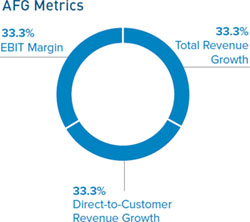 | The Compensation Committee considered the significant disruption occurring in the retail industry and the strategic work that would be necessary by the executives to accelerate the Company’s long-term growth in this environment. In light of this, the Committee provided an additional long-term incentive award to the NEOs and other senior executives focused on accelerating the strategic growth initiatives, expanding our direct-to-customer business, and maintaining the profitability of our stores. This AFG award is designed to encourage and reward long-term strategic achievements, as well as serve a retentive purpose for executives who are critical to executing the Company’s strategic plan. The AFG award covers a three-year performance period-2018-20-and is based on three equally-weighted metrics: total revenue growth, direct-to-customer revenue growth, and EBIT margin. Prior to granting this new award, the Finance Committee reviewed and approved the 2018-19 financial plan and the forecast for 2020 on which the metrics are based. |
In determining to grant this award and the behavior to be incentivized by it, the Committee first considered the existing executive incentive programs, including the annual cash incentive awards which are based on a combination of pre-tax income (or division omni-channel profit) and customer-centric objectives, and the long-term performance-based equity awards with metrics tied to a combination of average two-year net income and ROIC. Given the desire to accelerate the pace by which the Company drives growth, both organically and inorganically, the Committee believed that it was important to provide additional incentive directly focused on profitable top-line growth, which would complement the other incentive programs during this dynamic period.
 40 | Foot Locker, Inc. |
Executive Compensation
For Mr. Johnson, 100% of the award is in the form of PBRSUs, and he would earn a payout following the end of the performance period only if the performance goals are achieved. For each of the other NEOs, 75% of the award is in the form of PBRSUs and 25% is in the form of time-based RSUs, payable following the end of the performance period, subject to the achievement of the performance goals with regard to the PBRSUs.
| Target Value of Performance-Based Component ($) | Target Value of Time-Based Payout Component ($) | Total Target Value ($) | ||||
| R. Johnson | 5,000,000 | – | 5,000,000 | |||
| L. Peters | 750,000 | 250,000 | 1,000,000 | |||
| S. Jacobs | 1,125,000 | 375,000 | 1,500,000 | |||
| L. Kimble | 750,000 | 250,000 | 1,000,000 | |||
| P. Verma | 562,500 | 187,500 | 750,000 |
The percentage of achievement of the performance goals at the end of the performance period will be applied to the target number of PBRSUs granted to each of the executives to determine the actual number of PBRSUs that may be earned. The percentage of the target number of PBRSUs that may be earned at threshold is 25% and at maximum is 200% for each executive. If the threshold performance goals are not met, no PBRSUs will be earned or paid out to any executive.
As the AFG performance period is on-going, we have not disclosed the actual targets because we believe it would be competitively harmful to do so. At the end of the performance period-in 2021-the Committee will determine whether the performance goals have been achieved, and we will provide specific disclosure regarding the targets, performance results relative to those targets, and the earned payouts, if any, for the completed performance period. For the time-based component of the AFG applicable to the NEOs other than Mr. Johnson, the RSUs will vest in March 2021, subject to continuous employment by the executives.
Our long-term incentive program includes the performance-based LTIP awards and other long-term equity awards granted under the Stock Incentive Plan in the form of stock options, time-based restricted stock, and RSUs. Performance-based LTIP awards, and stock options, and time-based RSUs are granted annually, while time-vestedannually. Time-vested restricted stock andor special RSU awards normally are granted only in special circumstances, such as promotions, recruitment, and foror retention.
LTIP
The LTIP is designed to reward executives for achieving multi-year performance targets. OurThe LTIP is formula-driven, with targets established by the Compensation Committee based upon financial targets included in the business plan reviewed and approved each year by our Finance Committee and the Board. The LTIP pays out based upon the Company’s results, without individual performance adjustments. Key design features of the LTIP are:
Increased Equity Component.The payout structure of the LTIP award has
| Increased Equity Component | The payout structure of the LTIP award had been a mix of cash payable under the LTIP, and equity in the form of RSUs payable |
| Two-Year Performance Period and Additional One-Year Vesting Period | The performance period is two years; however, while award payouts are calculated following the end of the two-year performance period, payments require continued employment and are subject to forfeiture, as well as stock price fluctuations, for another year—that is, payments are not made until the end of a three-year period. |
| Net Income and ROIC Targets | The performance targets are based on adjusted net income (70%) and ROIC (30%) that are contained in the business and financial plan approved by the Finance Committee and the Board for the performance period. |
| Target Awards are a Percentage of Base Salary | The target awards are expressed as a percentage of initial base salary—that is, the base salary paid to the executive following any salary adjustments that take place on May 1 of the first year of the performance period, adjusted only for promotion-related salary increases. |
For the completed 2016-17 performance period (as further described below), all of the LTIP awards were denominated 25% in cash and 75% in RSUs.

|  |
 41 |
Executive Compensation
Two-Year Performance Period and Additional One-Year Vesting Period.The performance period is two years; however, while award payouts are calculated following the end of the two-year performance period, payments require continued employment and are subject to forfeiture, as well as stock price fluctuations, for another year—that is, payments are not made until the end of a three-year period.
Net Income and ROIC Targets.The performance targets are based on net income (70%) and ROIC (30%) that are contained in the business and financial plan adopted by the Finance Committee and the Board for the performance period.
Target Awards are a Percentage of Base Salary.The target awards are expressed as a percentage of initial base salary—that is, the base salary paid to the executive following any salary adjustments that take place on May 1 of the first year of the performance period, adjusted only for promotion-related salary increases. The target awards for the NEOs are listed in the following table:
| Name | Target Award as a Percentage of Base Salary | |
| R. Johnson | 250% | |
| L. Peters | 100% | |
| S. Jacobs | 100% | |
| L. Kimble | 75% | |
| P. Verma | 75% |
Determination of Payout for 2016-172017-18 LTIP Awards.Consistent with our high-performance culture, the Compensation Committee established rigorous net income and ROIC targets at the beginning of 20162017 for the 2016-17 LTIP2017-18 performance period and set a “performance floor” for each performance measure. The targets the Compensation Committee established were based on the Company achieving two-year average annual net income of $727.2 million (which accounts for 70% of the payout) and ROIC of 15.5% (which accounts for 30% of the payout). The Company achieved two-year average annual net income of $580.8$541.6 million and ROIC of 13.1%11.9% for this performance period, which were below the threshold performance floor. As a result, no payouts were earned for this performance period. TheSee page 36 for the targets, along with the adjusted actual performance for the period, and the calculation of ROIC are shown in the charts below:period.
| Threshold | Target | Maximum | Actual | |
| Average Annual Net Income (weighted 70%) | $595.4 million | $700.5 million | $840.6 million | $580.8 million |
| Two-Year Average ROIC (weighted 30%) | 14.2% | 16.3% | 19.2% | 13.1% |
| Payout as Percentage of Target Award | 25% | 100% | 200% | 0% |
Determination of Performance Targets for 2017-182018-19 LTIP Awards.In 2017,2018, the Compensation Committee established LTIP performance targets for the 2017-182018-19 performance period, which are also based on two-year average annual net income (70%) and ROIC (30%). SinceFor competitive reasons, since this performance period is still on-going, we have not disclosed the targets established for the period. The Committee will determine whether payouts have been earned following the end of the Company’s 20182019 fiscal year.year, and we will provide specific information on the targets and results after the completion of the performance period. If awards are earned for the current 2017-182018-19 performance period, payment will be made to participating executives in 2020,2021, following the completion of a one-year time-based vesting period.
 | 
|
Executive Compensation
ROIC Calculation for LTIP.Return on Invested Capital, or ROIC, is a non-GAAP financial measure. For purposes of calculating this long-term incentive, we define ROIC as follows:
| Operating Profit After Taxes | ||||
| Pre-tax income | ||||
| +/- | interest expense/income | |||
| + | implied interest portion of operating lease payments | |||
| +/- | Unusual/non-recurring items | |||
| + | LTIP award expense | |||
| = | Earnings before LTIP award expense, interest and taxes | |||
| - | Estimated income tax expense | |||
| = | Operating Profit After Taxes | |||
| ROIC = | ||||
| Average Invested Capital | ||||
| Average | ||||
| average year-end inventory | ||||
| non-interest-bearing current liabilities | ||||
| + | 13-month average inventory | |||
| + | average estimated asset base of capitalized operating leases | |||
| = | ||||
Certain items used in the calculation of ROIC for bonus purposes, such as the implied interest portion of operating lease payments, certain unusual or non-recurring items, average estimated asset base of capitalized operating leases, and 13-month average inventory, while calculated from our financial records, cannot be calculated from our audited financial statements. Prior to the Compensation Committee determining whether bonus targets have been achieved, the Company’s independent registered public accounting firm, at the request and for the restricted use of the Compensation Committee, reviews the bonus calculations to ensure that the payout is calculated in accordance with the plan. There is a calculation of basic ROIC, which is not precisely the same as the calculation used for incentive compensation purposes because of the exclusion of certain items (please see Page 44(see page 49 for a discussion of disregarded items, and a reconciliation to GAAP on Pages 17pages 16 through 19, of our 20172018 Annual Report on Form 10-K).
 42 | Foot Locker, Inc. |
Executive Compensation
Stock Options and RSUs
The Compensation Committee granted equity awards to the NEOs in 2018, splitting the total value of the award between stock options and time-based RSUs in 2017order to eachenhance the retentive value of the NEOs.LTI awards. In prior years the annual equity award was made in the form of stock options only. In deciding to grant the stock optionsthese awards and determining the value of the awards, the Compensation Committee considered each executive’s position and the competitive market for equivalent talent. For Mr. Johnson, the approximate grant date value of his stock option awardawards was equivalent to 200% of his base salary. These awards are shown in the chart below. The option exercise price is equal to the closing price of the Company’s common stockCommon Stock on the grant date. Stock options normally vest at the rate of one-third of the total grant per year over the first three years of the ten-year option term, subject to continuous service through each vesting date and accelerated vesting in certain limited circumstances. The Compensation Committee does not normally consider an executive’s gains from prior stock awards in granting new awards. The Committee determines the number of options granted based on a fixed value, using the Black-Scholes value on the grant date. The values shown below for the stock option grants are based on a Black ScholesBlack-Scholes value of $15.58$12.35 on the grant date.
| Name | Stock Options (#) | Grant Date Fair Value ($) | ||||||
| R. Johnson | 141,207 | 2,200,005 | ||||||
| L. Peters | 32,093 | 500,009 | ||||||
| S. Jacobs | 32,093 | 500,009 | ||||||
| L. Kimble | 28,884 | 450,013 | ||||||
| P. Verma | 14,442 | 225,006 | ||||||

|  |
Executive Compensation
| Name | Stock Options (#) | Grant Date Fair Value ($) | RSUs (#) | Grant Date Fair Value ($) | ||||
| R. Johnson | 91,093 | 1,124,999 | 25,123 | 1,125,008 | ||||
| L. Peters | 20,243 | 250,001 | 5,583 | 250,007 | ||||
| S. Jacobs | 20,243 | 250,001 | 5,583 | 250,007 | ||||
| L. Kimble | 18,219 | 225,005 | 5,025 | 225,020 | ||||
| P. Verma | 12,146 | 150,003 | 3,350 | 150,013 |
Special RSU Award
We normally make restricted stock or time-vested RSU awards only in special circumstances, such as related to promotions, recruitment, and retention, rather than as part of an executive’s normal compensation. Restricted stock and RSUs are valued based upon the share price on the grant date.
The Compensation Committee granted a special award of 43,030 RSUs to Mr. Verma valued at $1.5 million in connection with his promotion during the year. In deciding to grant this award and determining the value of the award, the Compensation Committee considered Mr. Verma’s expanded scope and responsibilities in his new role, the competitive market for equivalent talent, and the desire to retain Mr. Verma’s services as we execute our long-term strategic initiatives. Mr. Verma’s award will vest 50% on September 28, 2020 and 50% on September 28, 2021 and is subject to his continuous service through the vesting dates. The value of the RSU award is based on the closing stock price of $34.86 on the grant date.
Other than with regard to this special award, no awards of time-vested restricted stock or RSUs were granted to the NEOs in 2017.
Retirement Plan and Excess Cash Balance Plan
All U.S.-based associates and expatriate U.S. employees of the Company who meet the eligibility requirements are participants in the Foot Locker Retirement Plan (the “Retirement Plan”). The Retirement Plan and the method of calculating benefits payable under it are described on Page 59.page 63. All of the NEOs are participants in the Retirement Plan. The Internal Revenue Code (“IRC”) limits the amount of compensation that may be taken into consideration in determining an individual’s retirement benefits. Therefore, those participants in the Retirement Plan whose compensation exceeds the IRC limit are also participants in the Excess Cash Balance Plan, described on Page 59,page 63, which provides a benefit equal to the difference between the amount a participant receives from the Retirement Plan and the amount the participant would have received were it not for the IRC limits. The Retirement Plan and Excess Cash Balance Plan take into account only base salary and annual bonus in determining pension benefits. Therefore, long-term incentives, stock options, and stock awards have no effect on the calculation of benefits or payments under these plans.
The Company has a 401(k) Plan that is available to employees whose primary place of employment is in the United States, as well as to expatriate U.S. employees. Prior to January 1, 2018, the 401(k) Plan limited participation to employees who had attained at least the age of 21 and had completed one year of service consisting of 1,000 hours. Effective January 1, 2018, eligibleEligible associates may contribute to the 401(k) Plan following 28 days of employment and are eligible for Company matching contributions upon completion of one year of service consisting of at least 1,000 hours. All of the NEOs participate in the 401(k) Plan, other than Mr. Kimble. As of January 1, 2018,2019, the 401(k) Plan allows eligible employees to contribute up to 40% of their compensation on a pre-tax basis, subject to a maximum of $18,500.$19,000. The Company matches 25% of employees’ pre-tax contributions on up to the first 4% of the employees’ compensation (subject to certain limitations). The matching contribution is made in cash. Matching contributions are vested incrementally over the first five years of participation. Please seeSee Note 86 to the Summary Compensation Table on Pages 48pages 53 through 4954 for the amount of the Company match for each of the NEOs.
 | 
|
Executive Compensation
Supplemental Executive Retirement Plan
The Company maintains a Supplemental Executive Retirement Plan (the “SERP”), described on Page 60,page 64, for certain senior officers of the Company and other key employees, including the NEOs. The SERP is an unfunded plan that sets an annual target for each participant consisting of a percentage of base salary and annual bonus based on the Company’s performance against target. This is the same target as set under the Annual Bonus Plan. Contributions range from 4% to 12% of salary and annual bonus, depending on the Company’s performance against an established target, with an 8% contribution being made for target performance. The Compensation Committee establishes the SERP target each year, and it is normally the same as the performance target under
| 2019 Proxy Statement |  43 |
Executive Compensation
the Annual Bonus Plan.annual bonus plan. In addition, performance-based participant accounts accrue interest at the rate of 6% annually. The SERP also provides for the continuation of medical and dental insurance benefits following retirement to vested participants who were participants in the SERP prior to the start of the 2014 fiscal year when this benefit was closed to new participants.
Based upon the Company’s performance in 2017,2018, a credit of 4%7.3% of 20172018 base salary was made to the SERP for each of the NEOs. Credits to the SERP are based only on base salary and annual bonus, if paid; therefore, long-term incentives, stock options, and stock awards have no effect on the calculation of benefits or payments under this plan. As of the end of 2017,2018, the account balances of the NEOs ranged from $106,092$178,053 for Mr. Verma to $2,106,636$2,449,041 for Mr. Johnson. Under the terms of the SERP, executives are vested in their account balances based upon a combination of age and service. As of the end of 2017,2018, all of the NEOs, other than Mr. Verma who has not yet met the age and service requirements, were vested in the SERP.
International Assignment Compensation
We provide expatriate employees on long-term international assignments, such as Mr. Kimble, with additional benefits and allowances that are designed to minimize any financial detriment or gain to the employee from thean international assignment. For Mr. Kimble, who was the only NEO who was an expatriate employee in 2017,2018, we provided benefits and allowances for certain home leave, goods and services differential, dependent education, housing, relocation, automobile costs, and tax preparation assistance.
We provide the NEOs with certain perquisites, which the Compensation Committee believes to be reasonable and consistent with its overall objective of attracting and retaining talented executives. The Company provides the NEOs with an automobile allowance, financial planning, medical expense allowance, supplemental long-term disability insurance, and life insurance. In addition, the Company reimburses Mr. Johnson for reasonable expenses of using car service for transportation in the New York metropolitan area. In addition, weWe also provide for continuation of medical and dental insurance benefits following retirement to participants who vested participants in the SERP prior to the start of the 2014 fiscal year when the benefit became closed to new participants. We do not provide a gross-up to executives for the income tax liability they incur due to their receipt of these perquisites.
Executive Employment Agreements
As more fully described on Pages 49pages 54 through 52,55, we have employment agreements with each of our NEOs. Other than the agreementsagreement with Mr. Johnson as CEO, the agreements are substantially in the same form.
Our employment agreements with the NEOs provide for severance payments to the executive if we terminate the executive’s employment without cause or if the executive terminates his or her employment for good reason. These payments to the NEOs, calculated as if termination of employment occurred at the end of our last fiscal year, are set out in the tables on Pages 61pages 65 through 71.

|  |
Executive Compensation67.
The NEOs would receive an enhanced severance payment if the executive’s employment is terminated without cause or if the executive terminates employment for good reason within two years following a change in control. For an executive to receive the enhanced severance payment, two events must occur: first, employment must be terminated for one of the specified reasons, and second, this termination must occur within two years following a change in control. We believe that these provisions, which we have had in place for a number of years, provide appropriate protection to our executives, comparable to that available at other public companies, and, with regard to the enhanced severance following a change in control, protect us from losing key executives during a period when a change in control may be threatened or pending. None of the NEOs is entitled to a gross-up payment for any excise taxes that may become payable in connection with a change in control.
All of the NEOs have agreed in their employment contracts not to compete with the Company for two years following their termination of employment and not to hire Company employees during that same period. This restriction does not apply following a change in control.
 44 | Foot Locker, Inc. |
Executive Compensation
Procedures for Determining Compensation
Setting Compensation, Establishing Goals, and Evaluating Performance
As reflected in the following timeline, the Compensation Committee oversees a rigorous and comprehensive compensation approval, goal setting, and performance review process:

| Annual Review | • | The Compensation Committee reviews any feedback from shareholder engagement meetings | |
| and Approvals | regarding the compensation program. | ||
| (January - | |||
| • | At its February meeting, the Committee discusses further refined planning and preliminary | ||
| March) | recommendations for the | ||
 | |||
| • | At its March meeting, final recommendations are presented, and the Committee approves the executive compensation design, components, and awards for each executive, and establishes the applicable annual bonus and LTIP performance goals. | ||
| The Committee meets privately with the independent consultant to review and approve the CEO’s compensation. | |||
Compensation | • | During its meetings over this period, the Committee has preliminary discussions with management and compensation consultants regarding the compensation program design for the following year, including reviewing compensation trends, peer group composition, a competitive analysis of individual executives’ compensation relative to market, preliminary pay recommendations, and the current incentive payout forecast. The Committee provides feedback and direction regarding the program design for the next fiscal year. | |
| • | The Committee meets privately with the independent consultant regarding the CEO’s compensation. | ||
 | |||
| Additional Reviews (During Year) | 
| ||
| responsibility for annually reviewing the compensation paid to non-employee directors and making recommendations to the full Board regarding the directors’ compensation program. | |||
Executive Compensation
Each year, in advance of making compensation decisions for the forthcoming year, the Compensation Committee meets with management and reviews the Company’s overall executive compensation program in light of the Company’s long-term strategy and financial objectives approved by the Finance Committee and the Board. The Committee meets with management, the Company’s compensation consultant, and the Committee’s independent compensation consultant to review the executive compensation environment, including recent developments and trends in executive compensation relative to the Company’s executive compensation program, and a historical view of the pay-for-performance correlation in the program and any changes to the program being recommended by management or either of the consultants.
After the financial results for the prior year have been finalized and audited, the Compensation Committee meets to review and approve bonus and incentive compensation payments for the prior year and to review and approve compensation arrangements—base salaries, stock awards, and incentive plan targets—for the upcoming year. The Compensation Committee meets privately with its independent compensation consultant for the purpose of establishing the compensation of the CEO, including establishing target awards under the Annual Bonus Plan and the LTIP, and making stock awards to him under the Stock Incentive Plan. Except in the case of promotions or other unusual circumstances, the Compensation Committee considers granting stock awards only at this meeting, which is normally held within a few weeks following the issuance of the Company’s full-year earnings release for the prior year.
The Compensation Committee may hold other meetings during the year to review specific issues related to executive compensation, new developments in executive compensation, or other issues related to management resources. The Compensation Committee also has responsibility, along with the Nominating and Governance Committee, for annually reviewing compensation paid to non-employee directors and making recommendations to the full Board regarding the directors’ compensation program.Benchmarking Approach
Benchmarking Approach
We have established benchmarks for compensation, including cash and equity, for each NEO. These benchmarks are reviewed annually and are based upon compensation for comparable positions in a peer group consisting of publicly-traded athletic footwear and apparel retailers and other specialty retail companies having revenues of approximately one-third to two and one-half times the Company’s revenue. We also use the peer group data to assess the competitiveness of total direct compensation awarded to our senior executives and as a data point in designing compensation plans, benefits, and perquisites.
| 2019 Proxy Statement |  45 |
Executive Compensation
The Compensation Committee has determined that the following companies, comprisewhich comprised the peer group for 2018 compensations decisions, was the appropriate peer group for executive compensation purposes based upon the nature of their businesses, revenues, and the pool from which they recruit their executives. The companies included in our peer group
Peer Group for 2017 compensation decisions were:2018 Compensation Decisions
| Abercrombie & Fitch Co. | Dick’s Sporting Goods Inc. | Genesco Inc. |
| American Eagle Outfitters, Inc. | DSW Inc. | L Brands, Inc. |
| Ascena Retail Group, Inc. | The Finish Line Inc. | Ross Stores, Inc. |
| Autozone, Inc. | GameStop Corp. | Signet Jewelers Limited |
| Bed, Bath & Beyond Inc. | The Gap Inc. | Williams-Sonoma, Inc. |
| Caleres, Inc. |

| |  |
Executive Compensation
One goal of the Compensation Committee is to provide competitive total compensation opportunities for the NEOs that vary with Company performance. The Compensation Committee uses the peer group benchmark information as a reference point in evaluating executive compensation, assessing the competitiveness of total direct compensation awarded to our senior executives, and designing compensation plans, benefits, and perquisites; it does not, however, attempt to match the compensation of each executive position in the Company precisely with that of an equivalent position in the peer group. In general, the Compensation Committee looks to position an executive’s total compensation betweenat the median and 75th percentile of comparable positions at peer companies, consistent with the Company’s revenue in relation to peer companies. The Compensation Committee also considers other factors, including performance, responsibility, experience, tenure, internal equity, and market positioning, when determining compensation.
Changes to Peer Group for 2019 Compensation Planning
During 2018, the Committee reviewed the peer group in light of merger and acquisition activity affecting certain peer companies, as well as the standing of certain peer companies in terms of revenues and market capitalization relative to the peer group criteria and determined that a refresh of the peer group based on a revised set of criteria was appropriate. For 2019 compensation decisions, the peer group criteria is as follows: (i) companies having revenues of approximately 0.5 to 2 times the Company’s revenue and market capitalization of approximately 0.25 to 4 times the Company’s market capitalization; and (ii) select sub-industries within the consumer discretionary sector most comparable to the Company’s business-apparel retail; apparel, accessories, and luxury goods; footwear; home furnishing retail; internet and direct marketing retail; and specialty stores. Based on the updated criteria, the peer group for 2019 compensation planning, which is shown below, reflects a larger, more diverse group of peers:
 Deletions Deletions |  Additions Additions | Peer Group for 2019 Compensation Planning | ||||
| Abercrombie & Fitch Co. | Burlington Stores, Inc. | American Eagle Outfitters, Inc. | Ralph Lauren Corp. | |||
| Ascena Retail Group, Inc. | Expedia, Inc. | Bed Bath & Beyond Inc. | Sally Beauty Holdings, Inc. | |||
| Autozone, Inc. | Hanesbrands, Inc. | Burlington Stores, Inc. | Signet Jewelers Ltd. | |||
| Caleres, Inc. | Michaels Companies, Inc. | Dick’s Sporting Goods, Inc. | Skechers USA, Inc. | |||
| DSW Inc. |  | PVH Corp. |  | Expedia, Inc. | Tapestry, Inc. | |
| The Finish Line Inc. | Qurate Retail, Inc. | The Gap, Inc. | Tiffany & Co. | |||
| GameStop Corp. | Ralph Lauren Corp. | Hanesbrands, Inc. | Tractor Supply Co. | |||
| Genesco Inc. | Sally Beauty Holdings, Inc. | L Brands, Inc. | Ulta Beauty, Inc. | |||
| Ross Stores, Inc. | Skechers USA, Inc. | Michaels Companies, Inc. | Under Armour, Inc. | |||
| Williams Sonoma, Inc. | Tapestry, Inc. | PVH Corp. | Urban Outfitters, Inc. | |||
| Tiffany & Co. | Qurate Retail, Inc. | Wayfair, Inc. | ||||
| Tractor Supply Co. | ||||||
| Ulta Beauty, Inc. | ||||||
| Under Armour, Inc. | ||||||
| Urban Outfitters, Inc. | ||||||
| Wayfair, Inc. | ||||||
 46 | Foot Locker, Inc. |
Executive Compensation
Use of Compensation Consultants
The Compensation Committee has retained as its advisor a nationally-recognized executive compensation consultant—consultant, Compensation Advisory Partners (“CAP”)—, that is independent and performs no work for management. CAP reports directly to the Compensation Committee, meets with the Committee privately without management present, and regularly communicates privately with the Committee Chair. CAP also meets with the Nominating and Governance Committee regarding non-employee directors’ compensation and reports on related governance and trends. The Compensation Committee has assessed the independence of CAP based on standards promulgated by the SEC and concluded that no conflict of interest exists that would prevent it from serving as an independent consultant to the Committee. Each year, the Committee’s compensation consultantCAP reviews a report on risk in relation to the Company’s compensation policies and practices, provides a pay-for-performance analysis of our executive compensation program, and reviews the CEO’s compensation. In addition, each year the Compensation Committee’s consultantCAP reviews and makes recommendations regarding the compensation program for non-employee directors, and the Compensation Committee together with the Nominating and Governance Committee, considerconsiders the consultant’s report on the program. Management utilizes the services of ClearBridge Compensation Group, a nationally-recognized compensation consultant, to provide advice on the executive compensation program and plan design.
Management Involvement in Developing the Compensation Program
Management is involved in various aspects of developing the executive compensation program. Our Senior Vice President and Chief Human Resources Officer, Vice President—Global Total Rewards, and staff in the Human Resources Department work with our CEO to develop compensation recommendations for all corporate and executive officers other than the CEO. The CEO or the Senior Vice President and Chief Human Resources Officer reviews these proposals with the Compensation Committee Chair, and may make changes to the recommendations based upon hisher input, before the recommendations are presented to the Compensation Committee for review. Our Senior Vice President and General Counsel also attends meetings of the Compensation Committee and participates in some of these discussions and preparations.
 | 
|
Executive Compensation
Additional Information
Key Compensation Governance Policies
Independent Compensation Consultant
With regard to executive and director compensation matters, our Compensation Committee directly retains, and is advised by, an independent compensation consultant who performs no other work for the Company.
Clawback Policy
We have adopted a clawback policy that provides for the recovery of incentive compensation—paid in cash or equity—if the Compensation Committee determines that an executive (1) engaged in fraud or gross misconduct which results in an accounting adjustment, whether or not the adjustment results in a restatement of our financial statements.statements, or (2) committed a significant legal or compliance violation of the Company’s policies or Code of Business Conduct. The Compensation Committee is closely monitoring the proposed SEC rules regarding recoupment of incentive-based compensation and will amend the policy if necessary when the final rules are adopted.
Stock Ownership Guidelines
We have meaningful stock ownership guidelines for our senior executives. These are set at six times annual base salary for the CEO, three times annual base salary for executive vice presidents, two times annual base salary for senior vice presidents, and a multiple of annual base salary for other covered executives. If an executive has not met the ownership requirements following a five-year phase-in period, the executive is required to hold 100% of net shares acquired from the vesting of restricted stock or RSUs or the exercise of stock options until they comply with the stock ownership guidelines. At the end of 2017,2018, all of the NEOs met or exceeded their applicable ownership guidelines.
No Tax Gross-Ups
We do not provide a tax gross-up with regard to any compensation, benefit, or perquisite paid by the Company, other than our international assignment policy (“IAP”) or relocation program that is applicable to all employees. We also do not provide tax gross-ups for any amount paid to an executive upon termination of employment or in connection with a change in control.
| 2019 Proxy Statement |  47 |
Executive Compensation
Anti-Hedging Policy
We do not permit our executives to take short positions in our shares or to hedge their economic interest in their shares.
No Stock Option Repricing
Our Stock Incentive Plan does not permit the repricing of stock options without shareholder approval.

|  |
Executive Compensation
We believe that our compensation program encourages our NEOs to take energetic action to improve the Company’s performance without encouraging them to take undue risk. The performance-based annual cash bonusincentive and LTIP elements of the program are paid based upon performance as compared to the Company’s annual and two-year financial plans, which are prepared each year by the Company’s management and reviewed and approved by the Finance Committee and the Board. The AFG awards are based on the approved 2018-19 financial plan and 2020 forecast reviewed by the Finance Committee and the Board. No bonusesincentive awards are earned or paid unless the applicable performance goals are achieved. We believe that, on balance, the plans are reasonably achievable under normal business conditions. This encourages our executives to manage the business well without pressuring them to take undue risks in order to obtain a bonus payment.payout.
Our equity-based compensation for the NEOs is designed with a similar goal in mind. We believe that our equity grants are reasonable in relation to overall compensation. Stock options normally vest ratably over a three-year period and have a 10-year term, reducing the risk that an executive will take short-term action to inflate the price of the Company’s stock for a brief period.
LTIP payouts are calculated at the conclusion of a two-year performance period, but are not actually paid to the participant until after an additional year of vesting has been satisfied. In addition to serving as a retention vehicle, this also requires that the executive continue to have the value of the stock portion of his or her award at risk, dependent on fluctuations in stock price, for an additional year. It also allows a year to pass in which any issues concerning the Company’s operating or financial performance may come to light before payments are made.
In addition, there are certain other factors related to our compensation programs for the NEOs that we believe help reduce the likelihood that our compensation programs will encourage our executives to take undue risk, as described below. Please also see Page 45See page 50 for a discussion of compensation and risk in our compensation plans more generally, and the procedures we followed to evaluate this.risk.
 | 
|
Executive Compensation
| Description | |
| ROIC as Bonus Measurement | As a retail company, we believe that one of the potential risks we have is that management will attempt to achieve profit targets without taking into account the capital used, particularly working capital invested in inventory and operating leases. We have, therefore, designed our LTIP for senior management, including the NEOs, to take into account ROIC as well as net income in determining whether a bonus will be paid. |
| No Bonus Payments to Executives with Poor | We have designed our plans so that executives who receive a “Not Meeting Performance” rating under the Company’s annual performance appraisal process are not eligible to receive an annual bonus payment. This helps prevent an individual executive from taking any action inconsistent with the business plan or otherwise exposing the Company to undue risk. |
| Bonus Targets | Bonus targets are based on the financial plan that is reviewed and approved by the Board. |
| Incentive Payments Proportional to | We believe that our cash incentive payments are not outsized in relation to base salary. Mr. Johnson, as CEO, has the opportunity to earn at target |
| Bonus Caps | Annual cash bonus |
| Mix of Components | We use a mix of annual and long-term incentive components, as well as a mix between the use of cash and equity. |
 48 | Foot Locker, Inc. |
Executive Compensation
The Compensation Committee currently has delegated authority to its Chair to approve, between committee meetings, time-vested RSU awards up to 7,500 RSUs per individual award and stock option awards up to 25,000 shares per individual award, in both cases only to executives who are not corporate or executive officers of the Company, division chief executive officers, or general managers. It is expected that the Chair would use this authority to approve awards made during the course of the year in connection with promotions, new hires, or special retention purposes. Options are priced at fair market value on the date the Chair signs the approval, which is the grant date for awards made under this delegation authority. Similarly, the value of RSU awards is based on the fair market value on the date the Chair signs the approval. The Chair did not useused this authority three times in 2017.2018, approving stock options and time-based RSU awards. The Compensation Committee has not delegated authority to management to make stock option, restricted stock, RSU, or other equity-based awards.
Items Disregarded for Bonus Calculations
Annual Bonus and LTIP payments are formula-driven based upon Company performance, and our 20172018 program for the NEOs does not provide for discretionary adjustments based upon individual performance. The Compensation Committee may, however, in its sole discretion, determine to eliminate or reduce the amounts payable under these incentive programs, but has no discretion to increase Annual Bonus or LTIP payments. When establishing the targets, the Compensation Committee normally specifies certain items that it considers to be unusual or non-recurring, and these events, if they occur, are excluded when calculating payments. All of the references in this CD&A to target and actual performance levels refer to amounts after taking these adjustments into consideration.

|  |
Executive Compensation
Accounting and Tax Considerations of Executive Compensation
While we review both the accounting and tax effects of various components of compensation, these effects are not a significant factor in the Compensation Committee’s allocation of compensation among the different components. With respect to awards made before the 2017 tax reform legislation, it was the Committee’s intent that compensation paid to executive officers should generally be fully deductible for U.S. tax purposes, and, consistent with this intent, the Committee structured our bonus, long-term incentive, and stock option programs so that payments made under them may qualifygenerally qualified for the performance-based exception of Section 162(m) of the IRC (“Section 162(m)”). However, the Committee believes that in certain instances it is in the Company’s and our shareholders’ best interests to have the flexibility to pay compensation that is not deductible so that we may provide compensation consistent with our program and objectives.
The amendments to Section 162(m) that were made by the 2017 tax reform legislation are generally effective for tax years after December 31, 2017, but subject to a transition rule under which those amendments will not apply to compensation payable pursuant to a written binding contract that was in effect on November 2, 2017, and is not materially modified after that date. Pursuant to the 2017 tax reform legislation, Section 162(m) will apply to each employee who serves as the Company’s principal executive officer or principal financial officer during the taxable year, each other employee of the Company who is among the three most highly compensated officers during such taxable year, and any other employee who was a covered employee of the Company for any preceding taxable year beginning after December 31, 2016. In addition, the 2017 tax reform legislationU.S. Tax Reform Legislation amended Section 162(m) to eliminate the “performance-based compensation” exception effective for tax years beginning after December 31, 2017. The Committee continues2017, subject to assess the impact of the amendmentsa transition rule allowing companies to Section 162(m)deduct compensation payable pursuant to a written binding contract in effect on November 2, 2017 and other changes contained in the 2017 tax reform legislation on the Company’s executive compensation programs in the future.not materially modified after that date. Notwithstanding the change in the tax law, the Committee is committed to the principles of linking executive pay closely to the Company’s strategy and performance, establishing challenging and measureablemeasurable performance goals, and providing payout limits under annual and long-term incentive plans. Further, the Compensation Committee reserves the right to modify compensation that was initially intended to be exempt from Section 162(m) if it determines that such modifications are consistent with the Company’s business needs.
| 2019 Proxy Statement |  49 |
Executive Compensation
Compensation and Management Resources Committee Report
The Compensation Committee has reviewed and discussed the CD&A with management and, based on that review and discussion, has recommended to the Board that the CD&A be included in this Proxy Statement.
Members of the Compensation Committee
 |  |  |  |  | |
| Kimberly Underhill, Chair | Maxine Clark | ||||
| Alan D. Feldman | Steven Oakland | Cheryl Nido Turpin | |||
Compensation Committee Interlocks and Insider Participation
Maxine Clark, Alan D. Feldman, Steven Oakland, Cheryl Nido Turpin, and Kimberly Underhill served on the Compensation Committee during 2018. None of the committee members was an officer or employee of the Company or any of its subsidiaries, and there were no interlocks with other companies within the meaning of the SEC’s proxy rules.
The Company has completed a risk-related review and assessment of our compensation program and considered whetherconcluded that our executive compensation is not reasonably likely to result in a material adverse effect on the Company. As part of this review, the independent compensation consultant to the Compensation Committee reviewed risk in relation to the Company’s compensation policies and practices with the Company’s human resources executives directly involved in compensation matters. The consultant reviewed the compensation policies and practices in effect for corporate and division employees through the manager level, store managers, and store associates, and reviewed the features we have built into the compensation programs to discourage excessive risk taking by employees, including a balance between different elements of compensation, differing time periods for different elements, consistent Company-wide programs, plan performance targets based on the corporate budgeting process, and stock ownership guidelines for senior management.
 |  
|
|
|
| Foot Locker, Inc. |
This page intentionally left blank.
| Executive Compensation | Executive Compensation |
| (a) | (b) | (c) | (d) | (e) | (f) | (g) | (h) | (i) | (j) | |||||||||||||||||||||||||||||||||||||
| Name and Principal Position (1) | Year | Salary ($)(2) | Bonus ($)(3) | Stock Awards ($)(4)(5) | Option Awards ($)(4) | Non-Equity Incentive Plan Compensation ($)(6) | Change in Pension Value and Non-qualified Deferred Compensation Earnings ($)(7) | All Other Compensation ($)(8) | Total ($) | |||||||||||||||||||||||||||||||||||||
| Richard A. Johnson | 2017 | 1,100,000 | — | 2,750,061 | 2,200,005 | — | 294,161 | 48,995 | 6,393,222 | |||||||||||||||||||||||||||||||||||||
| Chairman, President and | 2016 | 1,087,500 | — | 2,062,522 | 2,200,016 | 2,599,932 | 403,443 | 572,455 | 8,925,868 | |||||||||||||||||||||||||||||||||||||
| Chief Executive Officer | 2015 | 1,037,500 | — | 918,793 | 3,328,479 | 2,866,278 | 420,164 | 49,353 | 8,620,567 | |||||||||||||||||||||||||||||||||||||
| Lauren B. Peters | 2017 | 675,000 | — | 506,314 | 500,009 | — | 174,281 | 7,646 | 1,863,250 | |||||||||||||||||||||||||||||||||||||
| Executive Vice President | 2016 | 657,500 | — | 1,579,759 | 450,010 | 714,088 | 205,626 | 84,011 | 3,690,994 | |||||||||||||||||||||||||||||||||||||
| and Chief Financial Officer | 2015 | 595,000 | — | 226,888 | 512,320 | 857,976 | 196,559 | 20,404 | 2,409,147 | |||||||||||||||||||||||||||||||||||||
| Stephen D. Jacobs | 2017 | 850,000 | — | 637,554 | 500,009 | — | 179,511 | 32,924 | 2,199,998 | |||||||||||||||||||||||||||||||||||||
| Executive Vice President and | 2016 | 844,445 | — | 2,654,792 | 450,010 | 952,238 | 222,934 | 117,513 | 5,241,932 | |||||||||||||||||||||||||||||||||||||
| Chief Executive Officer—North America | ||||||||||||||||||||||||||||||||||||||||||||||
| Lewis P. Kimble | 2017 | 650,000 | — | 365,679 | 450,013 | — | 263,152 | 386,641 | 2,115,485 | |||||||||||||||||||||||||||||||||||||
| Executive Vice President and | 2016 | 642,460 | — | 1,365,680 | 450,010 | 635,262 | 326,186 | 235,970 | 3,655,568 | |||||||||||||||||||||||||||||||||||||
| Chief Executive Officer—International | ||||||||||||||||||||||||||||||||||||||||||||||
| Pawan Verma | 2017 | 493,333 | — | 1,785,721 | 225,006 | — | 49,737 | 43,855 | 2,597,652 | |||||||||||||||||||||||||||||||||||||
| Executive Vice President and | 2016 | 461,250 | — | 261,603 | 225,005 | 360,252 | 70,795 | 239,928 | 1,618,833 | |||||||||||||||||||||||||||||||||||||
| Chief Information and Customer | 2015 | 216,071 | 455,095 | 1,665,162 | 225,105 | 208,958 | 49,650 | 80,988 | 2,901,029 | |||||||||||||||||||||||||||||||||||||
| Connectivity Officer | ||||||||||||||||||||||||||||||||||||||||||||||
| (a) | (b) | (c) | (d) | (e) | (f) | (g) | (h) | (i) | ||
| Salary | Stock Awards | Option Awards | Non-Equity Incentive Plan Compensation | Change inPension Value and Non-Qualified Deferred CompensationEarnings | All Other Compensation | Total | ||||
| Name and Principal Position | Year | ($)(1) | ($)(2)(3) | ($)(2) | ($)(4) | ($)(5) | ($)(6) | ($) | ||
| Richard A. Johnson | 2018 | 1,100,000 | 8,875,069 | 1,124,999 | 1,859,000 | 380,307 | 62,601 | 13,401,976 | ||
| Chairman, President and | 2017 | 1,100,000 | 2,750,061 | 2,200,005 | — | 294,161 | 48,995 | 6,393,222 | ||
| ChiefExecutive Officer | 2016 | 1,087,500 | 2,062,522 | 2,200,016 | 2,599,932 | 403,443 | 572,455 | 8,925,868 | ||
| Lauren B. Peters | 2018 | 675,000 | 1,925,101 | 250,001 | 427,781 | 182,072 | 13,404 | 3,473,359 | ||
| ExecutiveVice President and | 2017 | 675,000 | 506,314 | 500,009 | — | 174,281 | 7,646 | 1,863,250 | ||
| Chief Financial Officer | 2016 | 657,500 | 1,579,759 | 450,010 | 714,088 | 205,626 | 84,011 | 3,690,994 | ||
| Stephen D.“Jake” Jacobs | 2018 | 850,000 | 2,600,048 | 250,001 | 1,336,200 | 246,502 | 23,980 | 5,306,731 | ||
| ExecutiveVice President and | 2017 | 850,000 | 637,554 | 500,009 | — | 179,511 | 32,924 | 2,199,998 | ||
| ChiefExecutive Officer—North America | 2016 | 844,445 | 2,654,792 | 450,010 | 952,238 | 222,934 | 117,513 | 5,241,932 | ||
| LewisP.Kimble | 2018 | 650,000 | 1,712,620 | 225,005 | — | 247,830 | 1,314,603 | 4,150,058 | ||
| ExecutiveVice President and | 2017 | 650,000 | 365,679 | 450,013 | — | 263,152 | 386,641 | 2,115,485 | ||
| ChiefExecutive Officer—AsiaPacific | 2016 | 642,460 | 1,365,680 | 450,010 | 635,262 | 326,186 | 235,970 | 3,655,568 | ||
| PawanVerma | 2018 | 550,000 | 1,312,563 | 150,003 | 348,562 | 90,599 | 42,514 | 2,494,241 | ||
| ExecutiveVicePresident and | 2017 | 493,333 | 1,785,721 | 225,006 | — | 49,737 | 43,855 | 2,597,652 | ||
| ChiefInformationandCustomer Connectivity Officer | 2016 | 461,250 | 261,603 | 225,005 | 360,252 | 70,795 | 239,928 | 1,618,833 |
Notes to Summary Compensation Table
| The amounts in columns (c) and |
| Mr. Johnson |
| The amounts in these columns reflect the stock and option awards granted in the designated years. The amounts represent the aggregate grant date fair value of the awards granted in each respective year calculated in accordance with stock-based compensation accounting rules. A discussion of the assumptions used in computing the award values may be found in Note 21 to our financial statements in our |
| The amounts in this column include the grant date fair value of |

|  | 
|
Executive Compensation
| For 2018, this column reflects the cash incentive payouts made in 2019 under the Annual Bonus Plan for 2018, as shown in Table I below. No LTIP payouts were earned for the 2017-18 performance measurement period. For 2017, there were no cash incentive payouts made under the Annual Bonus Plan for 2017 and no LTIP payouts were earned for the 2016-17 performance measurement period. For 2016, this column reflects the sum of the cash incentive payouts made in 2017 under the Annual Bonus Plan for 2016 and the cash portion of the earned LTIP payout for the 2015-16 performance measurement period that was paid in 2018, as shown in Table |
I—Cash Incentive Payouts for 20162018
| Payout in 2019 | Payout in 2020 | |||||||||||||||
| LTIP 2017-18 | ||||||||||||||||
| Performance Period | Total | |||||||||||||||
| Annual Bonus Plan | (Cash Payout Earned— | As Shown in Summary | ||||||||||||||
| Payout in 2017 | Payout in 2018 | Cash Payment for 2018 | Payable in 2020) | Compensation Table | ||||||||||||
| Name | Annual Bonus Plan Cash Payment for 2016 ($) | LTIP 2015-16 Performance Period (Cash Payout Earned— Paid in 2018) ($) | Total As Shown in Summary Compensation Table ($) | ($) | ($) | |||||||||||
| R. Johnson | 1,301,738 | 1,298,194 | 2,599,932 | 1,859,000 | N/A | 1,859,000 | ||||||||||
| L. Peters | 393,514 | 320,574 | 714,088 | 427,781 | — | 427,781 | ||||||||||
| S. Jacobs | 521,867 | 430,371 | 952,238 | 1,336,200 | — | 1,336,200 | ||||||||||
| L. Kimble | 318,018 | 317,244 | 635,262 | — | — | |||||||||||
| P. Verma | 184,039 | 176,213 | 360,252 | 348,562 | — | 348,562 | ||||||||||
II—Cash Incentive Payouts for 20152016
| Payout in 2017 | Payout in 2018 | |||||||||||||||
| LTIP 2015-16 | ||||||||||||||||
| Performance Period | Total | |||||||||||||||
| Annual Bonus Plan | (Cash Payout Earned— | As Shown in Summary | ||||||||||||||
| Payout in 2016 | Payout in 2017 | Cash Payment for 2016 | Paid in 2018) | Compensation Table | ||||||||||||
| Name | Annual Bonus Plan Cash Payment for 2015 ($) | LTIP 2014-15 Performance Period (Cash Payout Earned— Paid in 2017) ($) | Total As Shown in Summary Compensation Table ($) | ($) | ($) | |||||||||||
| R. Johnson | 1,719,656 | 1,146,622 | 2,866,278 | 1,301,738 | 1,298,194 | 2,599,932 | ||||||||||
| L. Peters | 512,831 | 345,145 | 857,976 | 393,514 | 320,574 | 714,088 | ||||||||||
| S. Jacobs | 521,867 | 430,371 | 952,238 | |||||||||||||
| L. Kimble | 318,018 | 317,244 | 635,262 | |||||||||||||
| P. Verma | 143,255 | 65,703 | 208,958 | 184,039 | 176,213 | 360,252 | ||||||||||
| (5) | The amounts in this column represent the annual change in pension value during each of our last three fiscal years. |
| The amounts in this column represent perquisites and other compensation attributable to the executives for | ||
 
| | 2019 Proxy Statement |  |
Executive Compensation
53
| Name | Auto. Allow. ($) | Car Service Reimb. ($) | Univ. Life Ins. Prem. ($) | Med. Expense Reimb. ($) | Exec. Physical ($) | Supp. LTD Ins. Prem. ($) | Accrual for Post- Ret. Med. | Financial Planning ($) | 401(k) Match ($) | Foreign Earnings ($) | Expatriate Tax Payments ($) | Total ($) | ||||||||||||||||||||||||||||||||||||
| R. Johnson | 9,487 | 11,706 | 5,186 | 5,025 | 978 | 4,913 | — | 9,000 | 2,700 | — | — | 48,995 | ||||||||||||||||||||||||||||||||||||
| L. Peters | — | — | 2,897 | 1,007 | 1,042 | — | — | — | 2,700 | — | — | 7,646 | ||||||||||||||||||||||||||||||||||||
| S. Jacobs | 26,648 | — | — | 43 | — | — | 3,533 | — | 2,700 | — | — | 32,924 | ||||||||||||||||||||||||||||||||||||
| L. Kimble | — | — | 3,733 | 765 | — | — | — | — | — | 171,274 | 210,869 | 386,641 | ||||||||||||||||||||||||||||||||||||
| P. Verma | 15,094 | — | 2,540 | 5,000 | 749 | 5,523 | — | 12,249 | 2,700 | — | — | 43,855 | ||||||||||||||||||||||||||||||||||||
Executive Compensation
| Car | Med. | Supp. | Expatriate | |||||||
| Auto. | Service | Univ. Life | Expense | LTD Ins. | Financial | 401(k) | Foreign | Tax | ||
| Allow. | Reimb. | Ins. Prem. | Reimb. | Prem. | Planning | Match | Earnings | Payments | Total | |
| Name | ($) | ($) | ($) | ($) | ($) | ($) | ($) | ($) | ($) | ($) |
| R. Johnson | 4,845 | 28,872 | 4,927 | 6,933 | 3,662 | 10,612 | 2,750 | – | — | 62,601 |
| L. Peters | 3,963 | – | 2,763 | 3,928 | – | – | 2,750 | – | — | 13,404 |
| S. Jacobs | 15,975 | – | – | 5,255 | – | – | 2,750 | – | — | 23,980 |
| L. Kimble | – | – | 3,581 | 766 | – | – | – | 14,243 | 1,296,013 | 1,314,603 |
| P. Verma | 18,161 | – | 2,870 | 4,778 | 3,314 | 13,391 | – | – | — | 42,514 |
The Company has established a trust for certain benefit plans, arrangements, and agreements, including the SERP, the Foot Locker Excess Cash Balance Plan, the executive employment agreements, and other benefit plans, agreements or arrangements that may be covered at a later date (collectively, the “Benefit Obligations”). Upon the occurrence of a Potential Change in Control of the Company as defined in the trust agreement, the Company is required to fund the trust with an amount sufficient to pay the total amount of the Benefit Obligations. Following the occurrence, and during the pendency, of a Potential Change in Control, the trustee would be required to make payments of Benefit Obligations to the extent these payments are not made by the Company.
We have employment agreements with each of the NEOs, and we describe the material terms of each of these agreements below. Information on estimated potential payments and benefits upon termination of the agreements is described underPotential Payments Upon Termination or Change in Controlbeginning on Page 61.page 65.
Richard A. Johnson
Position.We entered intohave an employment agreement with Mr. Johnson on November 6, 2014 in connection with his promotion to serveposition as our Chief Executive Officer.
Term.The term of this agreement began on December 1, 2014 and ends on January 31, 2019.2021. The agreement contains an “evergreen” renewal provision that provides for additional one-year renewals of the employment term, unless either party gives notice of non-renewal one year prior to the end of the then-current term.
Base Salary and Bonus.During the term of the agreement, the Company shall pay Mr. Johnson an annual base salary of not less than $1,000,000. Mr. Johnson’s 20172018 base salary rate was $1,100,000. As Chief Executive Officer, for 2017,2018, Mr. Johnson’s annual bonus at target under the Annual Bonus Plan was 150%200% of his base salary, and his annual bonus at target under the LTIP was 250% of his base salary at the start of the performance period.
Stock Awards.Mr. Johnson’s agreement provided for certain restricted stock and stock option awards effective December 1, 2014, with vesting subject to his continued employment with the Company.
Benefit Plans and Perquisites.Mr. Johnson is entitled to participate in all bonus, incentive, and equity plans offered to senior executives. He is also eligible to participate in all pension, welfare,executives, including company-paid life insurance, long-term disability coverage, and fringe benefit plansreimbursement for certain medical, transportation, and perquisites offered to senior executives. The benefits and perquisites available to Mr. Johnson include:
 | 
|
Executive Compensationfinancial planning expenses.
Non-Compete Provision.Mr. Johnson’s agreement provides that he may not compete with the Company or solicit our employees for two years following the termination of his employment agreement.
Certain Defined Terms in the Agreement:
“Cause” means with regard to Mr. Johnson:
 54 | Foot Locker, Inc. | |
“Change in Control”means any of the following:
Executive Compensation
“GoodCertain Defined Terms. Mr. Johnson’s agreement includes definitions of certain terms such as “Cause” (i.e., for Mr. Johnson’s dismissal), “Good Reason”means, (i.e., for Mr. Johnson’s resignation), and “Change in Control” (which includes, among other things, the acquisition of 35% or more of the Company’s outstanding stock).
Other NEOs
Lauren B. Peters, Stephen D. Jacobs, Lewis P. Kimble, and Pawan Verma
Position/Term/Base Salary.We have substantially identical employment agreements with these executives in their current positions, as follows:
| Current Base | |||||||
| Current Term | Salary Rate | ||||||
| Name | Position | End Date | |||||
| L. Peters | Executive Vice President and Chief Financial Officer | 1/31/ | 2020 | 675,000 | |||
| S. Jacobs | Executive Vice President and Chief Executive Officer—North America | 1/31/ | 2020 | 850,000 | |||
| L. Kimble | Executive Vice President and Chief Executive Officer— | Asia Pacific | 1/31/ | 2020 | 650,000 | ||
| P. Verma | Executive Vice President and Chief Information and Customer Connectivity Officer | 1/31/ | 2020 | 550,000 |

|  |
Executive Compensation
The terms of the agreements will automatically be extended for another year unless notice of non-renewal is given by the October 31 prior to the then-current expiration of the term. We pay these executives annual base salaries at rates not less than their salaries at the start of their agreements. The executives’ base salaries for 20172018 are shown in the table above.
Benefit Plans and Perquisites. These executives are entitled to participate in all benefit plans and arrangements in effect at the start of the agreement, including retirement plans, Annual Bonus Plan, LTIP, medical, dental, and disability plans, and any other plans subsequently offered to our senior executives.
Non-Compete Provision.The executives’ agreements provide that they may not compete with the Company or solicit our employees for two years following the termination of their employment agreements.
Certain Defined TermsTerms. The executives’ agreements include definitions of certain terms such as “Cause” (i.e., for the executive’s dismissal), “Good Reason” (i.e., for the executive’s resignation), “Change in Control” (which includes, among other things, the Agreements:acquisition of 35% or more of the Company’s outstanding stock), and “Disability.”
“Cause”means each executive’s:
 55 |
“Change in Control”means any of the following:
“Disability”means:
“Good Reason”means:Executive Compensation
Prior to a Change in Control,
Following a Change in Control,
 | 
|
Executive Compensation
At any time,
Grants of Plan-Based Awards Table
The following table shows the awards made to the NEOs in 20172018 under the Annual Bonus Plan and the LTIP, as well as the AFG awards and RSU and stock option awards under the Stock Incentive Plan:
| Estimated Future Payouts Under Non-Equity Incentive Plan Awards | Estimated Future Payouts Under Equity Incentive Plan Awards | |||||||||||||||||||||||||||||||||||||||||
| (a) | (b) | (c) | (d) | (e) | (f) | (g) | (h) | (i) | (j) | (k) | (l) | |||||||||||||||||||||||||||||||
| All | ||||||||||||||||||||||||||||||||||||||||||
| All | Other | Grant | ||||||||||||||||||||||||||||||||||||||||
| Other | Option | Date | ||||||||||||||||||||||||||||||||||||||||
| Stock | Awards: | Fair | ||||||||||||||||||||||||||||||||||||||||
| Awards: | Number of | Exercise | Value of | |||||||||||||||||||||||||||||||||||||||
| Number of | Securities | or Base | Stock | |||||||||||||||||||||||||||||||||||||||
| Shares | Under- | Price of | and | |||||||||||||||||||||||||||||||||||||||
| of Stock | lying | Option | Option | |||||||||||||||||||||||||||||||||||||||
| Threshold | Target | Maximum | Threshold | Target | Maximum | or Units | Options | Awards | Awards | |||||||||||||||||||||||||||||||||
| Name | Grant Date | ($) | ($) | ($) | (#) | (#) | (#) | (#) | (#) | ($/Sh) | ($)(5) | |||||||||||||||||||||||||||||||
| R. Johnson | 03/22/17(1) | 412,500 | 1,650,000 | 2,887,500 | ||||||||||||||||||||||||||||||||||||||
| 03/22/17(2) | 171,875 | 687,500 | 1,375,000 | |||||||||||||||||||||||||||||||||||||||
| 03/22/17(2) | 9,440 | 37,760 | 75,519 | 2,750,061 | ||||||||||||||||||||||||||||||||||||||
| 03/22/17(3) | 141,207 | 72.83 | 2,200,005 | |||||||||||||||||||||||||||||||||||||||
| L. Peters | 03/22/17(1) | 126,563 | 506,250 | 885,938 | ||||||||||||||||||||||||||||||||||||||
| 03/22/17(2) | 42,188 | 168,750 | 337,500 | |||||||||||||||||||||||||||||||||||||||
| 03/22/17(2) | 1,738 | 6,952 | 13,903 | 506,314 | ||||||||||||||||||||||||||||||||||||||
| 03/22/17(3) | 32,093 | 72.83 | 500,009 | |||||||||||||||||||||||||||||||||||||||
| S. Jacobs | 03/22/17(1) | 212,500 | 850,000 | 1,487,500 | ||||||||||||||||||||||||||||||||||||||
| 03/22/17(2) | 53,125 | 212,500 | 425,000 | |||||||||||||||||||||||||||||||||||||||
| 03/22/17(2) | 2,189 | 8,754 | 17,507 | 637,554 | ||||||||||||||||||||||||||||||||||||||
| 03/22/17(3) | 32,093 | 72.83 | 500,009 | |||||||||||||||||||||||||||||||||||||||
| L. Kimble | 03/22/17(1) | 121,875 | 487,500 | 853,125 | ||||||||||||||||||||||||||||||||||||||
| 03/22/17(2) | 30,469 | 121,875 | 243,750 | |||||||||||||||||||||||||||||||||||||||
| 03/22/17(2) | 1,256 | 5,021 | 10,041 | 365,679 | ||||||||||||||||||||||||||||||||||||||
| 03/22/17(3) | 28,884 | 72.83 | 450,013 | |||||||||||||||||||||||||||||||||||||||
| P. Verma | 03/22/17(1) | 38,384 | 153,538 | 268,691 | ||||||||||||||||||||||||||||||||||||||
| 10/01/17(1) | 35,024 | 140,094 | 245,165 | |||||||||||||||||||||||||||||||||||||||
| 03/22/17(2) | 7,266 | 29,063 | 58,125 | |||||||||||||||||||||||||||||||||||||||
| 10/01/17(2) | 17,188 | 68,750 | 70,047 | |||||||||||||||||||||||||||||||||||||||
| 03/22/17(2) | 898 | 3,592 | 7,183 | 261,605 | ||||||||||||||||||||||||||||||||||||||
| 10/01/17(2) | 113 | 452 | 905 | 15,919 | ||||||||||||||||||||||||||||||||||||||
| 10/01/17(2) | 57 | 232 | 465 | 8,171 | ||||||||||||||||||||||||||||||||||||||
| 03/22/17(3) | 14,442 | 72.83 | 225,006 | |||||||||||||||||||||||||||||||||||||||
| 09/28/17(4) | 43,030 | 1,500,026 | ||||||||||||||||||||||||||||||||||||||||

|  | |||||||||||||||||||||||||||||||||||||||||||||||||||||||||||||||||||||||||||||||||||||||||||||||||||||||||||||||||||||||||||||||||||||||||||||||||||||||||||||||||||||||||||||||||||||||||||||||||||||||||||||||||||||||||||||||||||||||||||||||||||||||||||||||||||||||||||||||||||||||||||||||||||||||||||||||||||||||||||||||||||||||||||||||||||||||||||||||||||||||||||||||||||||||||||||||||||||||||||||||||||||||||||||||||
Executive Compensation
Notes to Grants of Plan-Based Awards Table
| (1) | Annual Incentive Awards |